The post Top 15 Trawlers for 2023 appeared first on Yachting.
]]>Top Trawlers
The following 15 trawlers are all vessels we’ve written about. They are listed in no particular order.
- Nordhavn 96: Built for an owner who desired to self-sufficiently while cruising the world, literally.
- Beneteau Grand Trawler 62: This trawler can travel nonstop for 1,000 nautical miles.
- Kadey-Krogen 52: This twin-engine-capable, all-oceans trawler is a solid fit for voyaging cruising couples.
- Bering Yachts B76: The B76 is the builder’s first fully custom trawler in this size range.
- Ranger Tugs R-43 Command Bridge: This vessel is equally comfortable at a 7-knot stroll or an 18-knot jog.
- Beneteau 48 Swift Trawler: Based on the builder’s Swift Trawler 47, this yacht has a resin-infused fiberglass hull.
- Kadey-Krogen 50 Open: The 50 Open can cruise at 6 knots nonstop for 5,000 nautical miles.
- Outer Reef 620 Trident: It has a three-stateroom layout and optional 600 hp Cummins diesels.
- Grand Banks 60 Skylounge: This yacht is efficient across a variety of cruising speeds.
- Krogen Express 52: Headroom to spare, two staterooms, a chef-ready galley and long range define this trawler yacht.
- Grand Banks 85 Skylounge: Grand Banks’ V-warp hull form makes for a level running attitude, seakindliness and long range.
- Vicem Yachts 82 Classic: Construction is in cold-molded, strip-planked mahogany with epoxy.
- Outer Reef 610 Motoryacht: Power on this Outer Reef is a pair of 500 hp John Deere 6090 diesels.
- Nordhavn 59 Coastal Pilot: Did someone say this is a 20-knot Nordhavn?
- Marlow 58E: A high level of customization and admirable performance are at the heart of the Marlow 58E.
Nordhavn 96
The Nordhavn 96 is the yacht builder’s second-largest yacht its 17-model fleet, which ranges from 41 to 120 feet length overall. (There is a new 112 on the drawing table.) The builder says the N96 is based on its earlier 86-footer with a 10-foot cockpit extension, which increases both main-deck, skylounge and below-deck volume. The N96 we reviewed was built by an owner who previously had an 86-foot Nordhavn, but with his plans for extended cruises to remote destinations, the 96 was the right size for his voyaging plans. In fact, since the owner took delivery of the boat, it has been on a continuous circumnavigation.
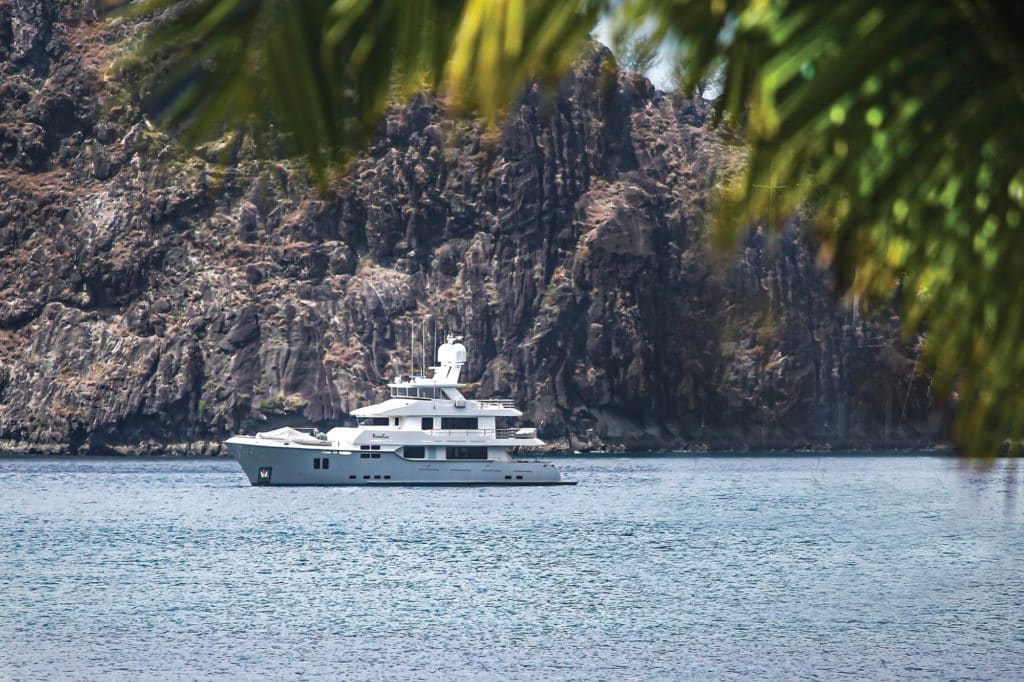
Quick Specifications
| Length Overall: | 96’7” |
| Maximum Beam: | 24’0” |
| Fuel Capacity: | 7,000 Gal. |
| Freshwater Capacity: | 900 Gal. |
| Draft: | 8’2” |
| Displacement: | 400,000 lb. |
Beneteau Grand Trawler 62
Beneteau’s Grand Trawler 62 has 1,000-plus-mile range and 20-knot speed with twin 730 hp i6 MAN diesels. The Grand Trawler 62 is the builder’s flagship in its Trawler series, which also includes the Swift Trawler 35, Swift Trawler 41 Sedan, Swift Trawler 41 Fly and Swift Trawler 48. Small touches set the Beneteau Grand Trawler 62 apart. They include sea rails on all lockers to keep stowed food and gear in place, leather-wrapped interior handrails for security in a seaway, and leather drawer pulls like those found on larger yachts. Long-range cruising accommodations include a full-beam master stateroom aft, a forepeak VIP and twin-berth guest stateroom. A Quick X3 gyrostabilizer helps mitigate any potential rocking and rolling on rough days.
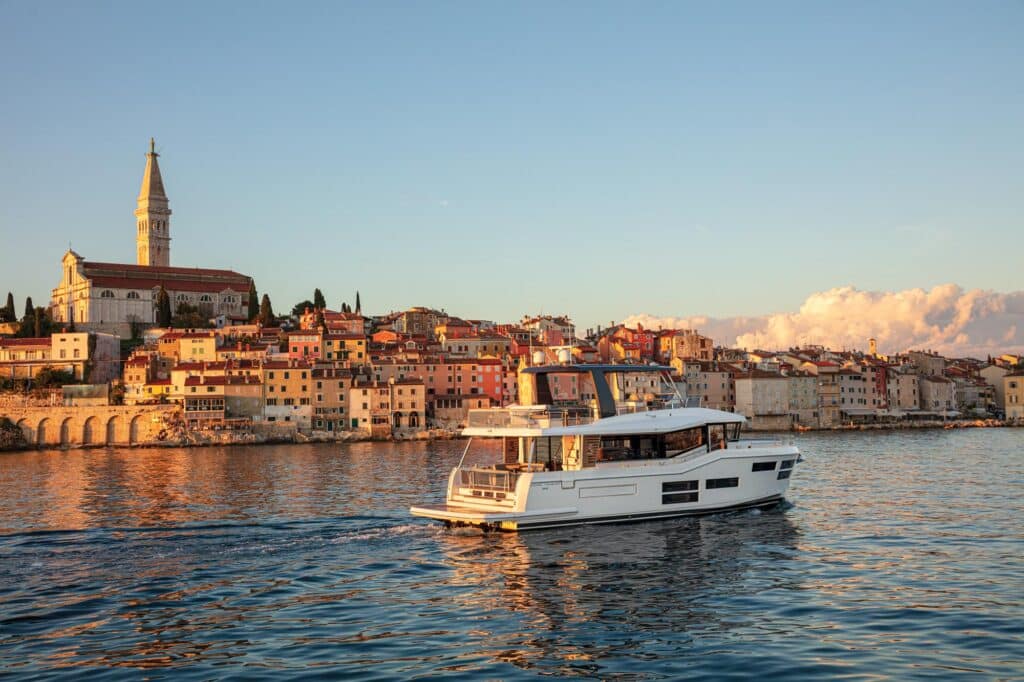
Quick Specifications
| Length Overall: | 62’2” |
| Maximum Beam: | 17’10” |
| Fuel Capacity: | 1,022 Gal. |
| Freshwater Capacity: | 222 Gal. |
| Draft: | 4’7” |
| Displacement (light): | 61,729 lb. |
Kadey-Krogen 52
The Kadey-Krogen 52 is the trawler-yacht builder’s smallest offering in its raised-pilothouse series, complete with a Portuguese Bridge. Owners can choose from either a two- or three-stateroom layout, and between a single-diesel engine or twin-diesel engines, for owners seeking redundancy. The standard engine is a 231 hp John Deere diesel. With the single-engine setup, draft is 5’5” and with twins it’s a shallower 4’6”. At 6 knots, range is an ocean-crossing 4,850 nautical miles. At 7 knots, it’s 3,300 nm. At 9 knots, it 1,700 nm. The builder states, “The entire Krogen 52 is built from only three molded pieces for maximized structural integrity. There are no additional secondary bonds or caulk joints that can inevitably cause issues. All deck and superstructures are cored and vacuum-bagged to maximize strength while minimizing weight.” Additionally, six longitudinal stringers enhance overall strength.
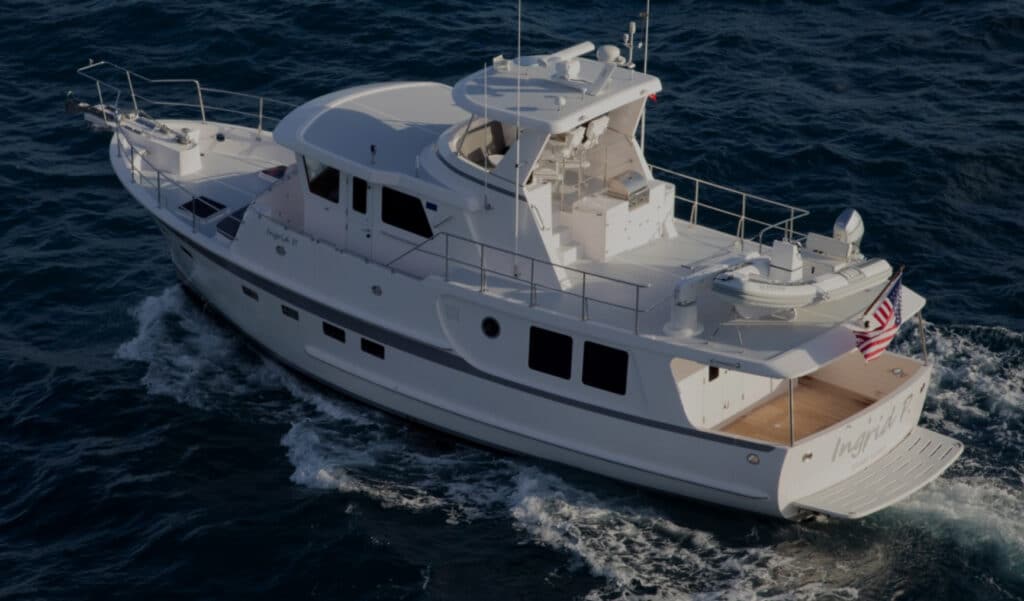
Quick Specifications
| Length Overall: | 57’9” |
| Maximum Beam: | 17’9” |
| Fuel Capacity: | 1,400 Gal. |
| Freshwater Capacity: | 400 Gal. |
| Draft: | 5’5” (single) 4’6” (twins) |
| Displacement: | 70,000 lb. |
Bering Yachts B76
Lemanja is the first custom boat that Bering has built in this size range. The yacht is notable for its steel hull and aluminum superstructure, and for its 4,000-nautical-mile-plus range with its twin 404 hp Cummins QSL9 diesel engines. As rugged as the Bering 76 is built on the outside, it also offers homelike comforts in its skylounge inside, offering panoramic views out large windows surrounding the space. Sole-to-ceiling glass offers similar views in the open-plan salon. Accommodations are fox six guests in three staterooms with a master stateroom and two guest staterooms, plus crew accommodations. In addition to its traditional diesel engines, the B76 has a solar-rechargeable battery bank for hybrid propulsion.
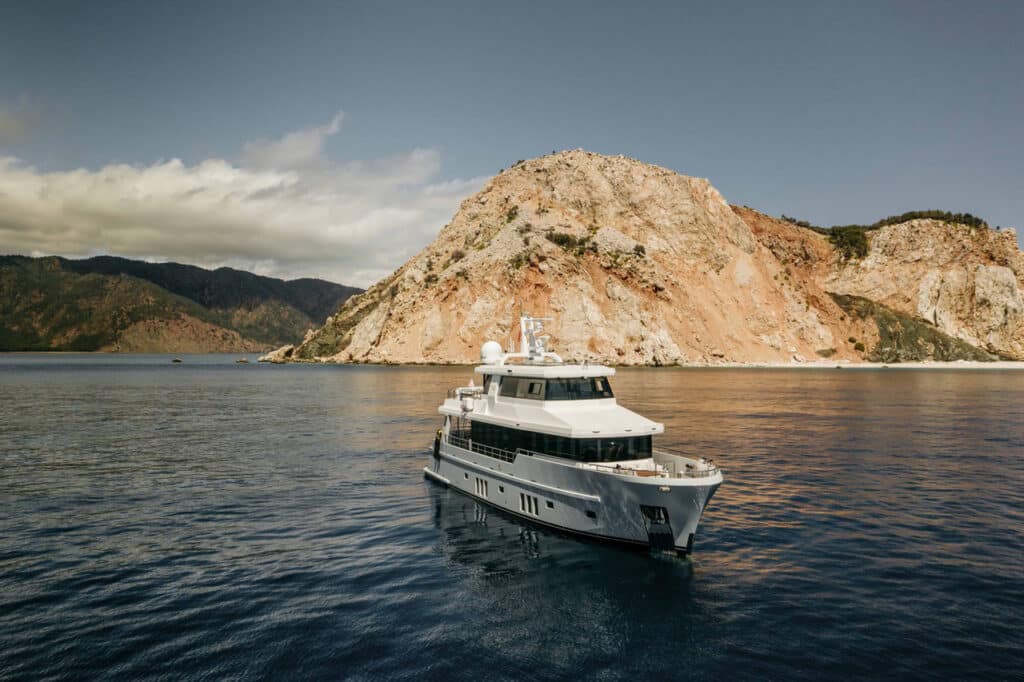
Quick Specifications
| Length Overall: | 73’3” |
| Maximum Beam: | 19’3” |
| Fuel Capacity: | 6,750 Gal. |
| Freshwater Capacity: | 946 Gal. |
| Draft: | 6’5” |
| Displacement: | 287,000 lb. |
Ranger Tugs R-43 Command Bridge
The Ranger Tugs R-43 Command Bridge is a long-distance cruiser with creature comforts. Our expert found the R-43 Command Bridge to be a solid candidate to cruise The Great Loop. We agree. Twin Volvo Penta IPS450 pod drives give the boat efficient low and high cruise speeds at 7 and 18 knots, respectively. For those that have work during their cruise, the R-43 Command bridge’s master stateroom is set up with an office with a desk. Long trips require extra stowage and a way to clean salty clothes, so on the R-43 Command Bridge there is a washer, dryer, auxiliary refrigerator/freezer and stowage under the dinette, which rises on electric rams. Voyagers who buy a R-43 Commander Bridge can opt for a Factory Delivery Experience, which is three days of instruction on Puget Sound, and includes in boat systems, handling and maintenance.
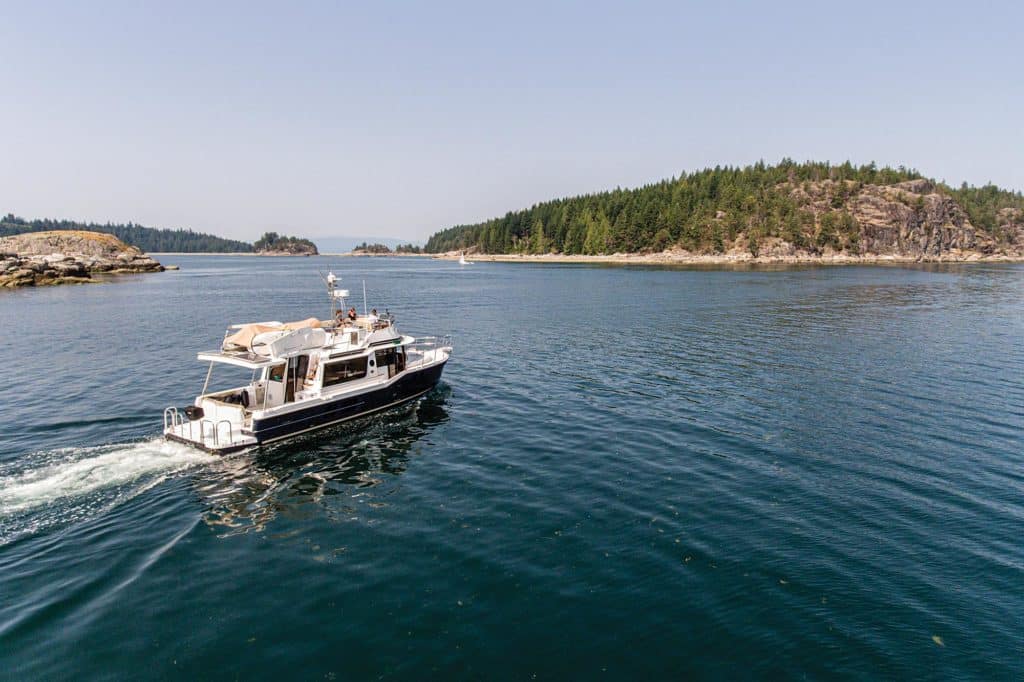
Quick Specifications
| Length Overall: | 46’9” |
| Maximum Beam: | 14’ |
| Fuel Capacity: | 300 Gal. |
| Freshwater Capacity: | 120 Gal. |
| Draft: | 3’6” |
| Engines: | 2/Volvo Penta IPS450s |
Beneteau Swift Trawler 48
The Beneteau Swift Trawler 48 has a 1,300-nautical-mile range at 8 knots, but can also speed away at 26 knots if the weather goes south in a hurry. Based on the builder’s 47-footer, the three-stateroom, two-head Swift Trawler 48 has a resin-infused fiberglass hull. Power is a pair of 425 hp Cummins diesels. The main-deck layout includes a galley aft setup, which is accessible to the cockpit. There, the seating and dining area can be fully enclosed, with tracks in place for side curtains. The helmsman is kept comfortable on long passages with a bolstered, pedestal bucket-style seat with a flip-up footrest. The Swift Trawler 48 we reviewed had upgraded 12-inch Raymarine HybridTouch displays (9-inch screens are standard).
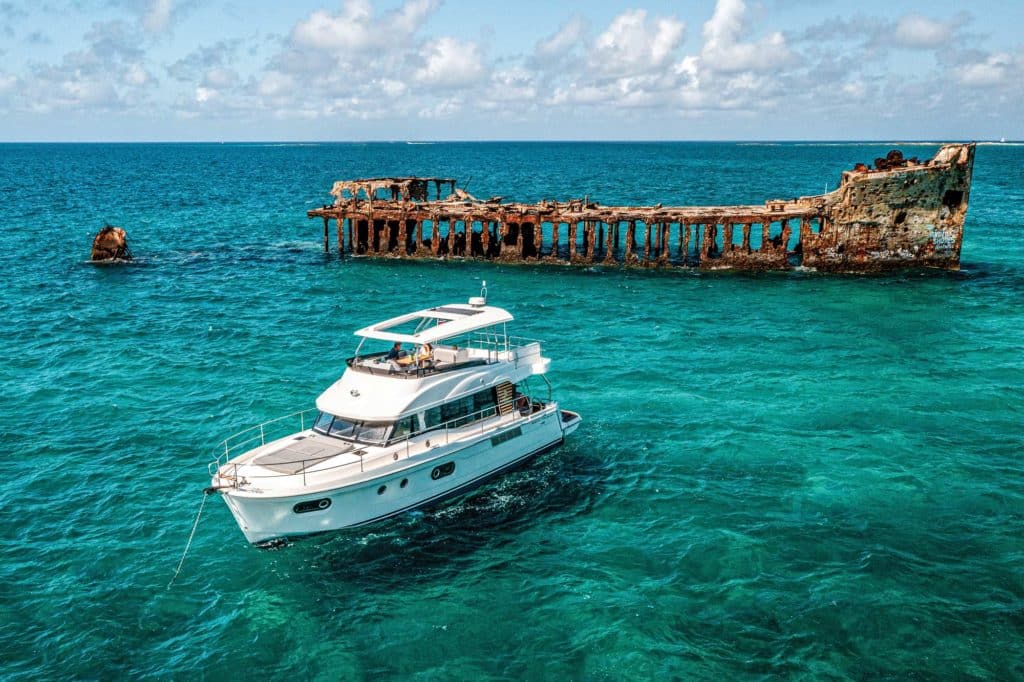
Quick Specifications
| Length Overall: | 48’4” |
| Maximum Beam: | 14’9” |
| Fuel Capacity: | 510 Gal. |
| Freshwater Capacity: | 169 Gal. |
| Draft: | 3’10” |
| Displacement (light): | 27,896 lb. |
Kadey-Krogen 50 Open
Designed for serious extended cruising, Kadey-Krogen Yachts 50 Open provides owners with amenities that will enhance those longer passages. The galley is fitted with a Sub-Zero refrigerator and freezer, a four-burner Wolf range, a microwave and an optional dishwasher. Unlike in many trawlers and their traditional pilothouse design, the galley is located on the same level as the helm and salon. Belowdecks is the master stateroom amidships with two hanging lockers, 12 cabinets, additional drawers for stowage and an en suite head, shower and two sinks. Forward of the master is an office. The 50 Open’s hull has soft chines and a curved after end, much like the characteristics of a sailboat built for cruising. The result is an efficient hull form that provides a gentle landing into troughs when the sea gets a temper. This trawler can cruise at 6 knots for 5,000 nautical miles; 7 knots for 3,000 nautical miles; 8 knots for 2,100 nautical miles; and 9 knots for 1,200 nautical miles.
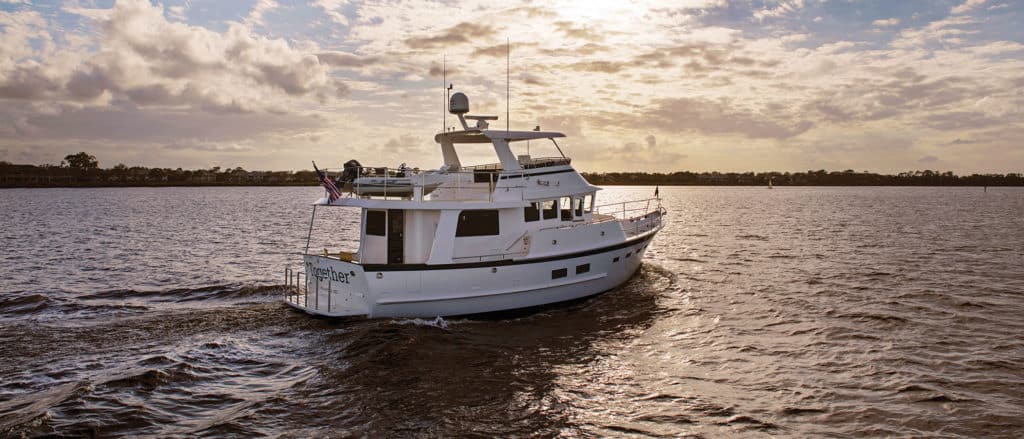
Quick Specifications
| Length Overall: | 52’9” |
| Maximum Beam: | 17’5” |
| Fuel Capacity: | 1,240 Gal. |
| Freshwater Capacity: | 400 Gal. |
| Draft: | 5’4” |
| Displacement: | 68,000 lb. |
Outer Reef 620 Trident
Outer Reef Yachts 620 Trident delivers a three-stateroom layout and optional 600 hp Cummins diesels that allow this vessel to approach a top hop of 21 knots. Cruising speed is a little over 16 knots, burning about 34 gallons of fuel per hour at 2,750 rpm. The amidships master stateroom has 6-foot-8-inch headroom, a walk-in closet and a shower enclosed in smoked glass. In the forepeak VIP stateroom, there are seven drawers, a hanging locker, a 31-inch Samsung TV and 7-foot headroom. The portside guest stateroom can convert to an office, too. The aft galley has a U-shape countertop, a three-burner electric cooktop, a Bosch microwave and a Vitrifrigo refrigerator and freezer. Cherry, walnut and oak are the available wood options.
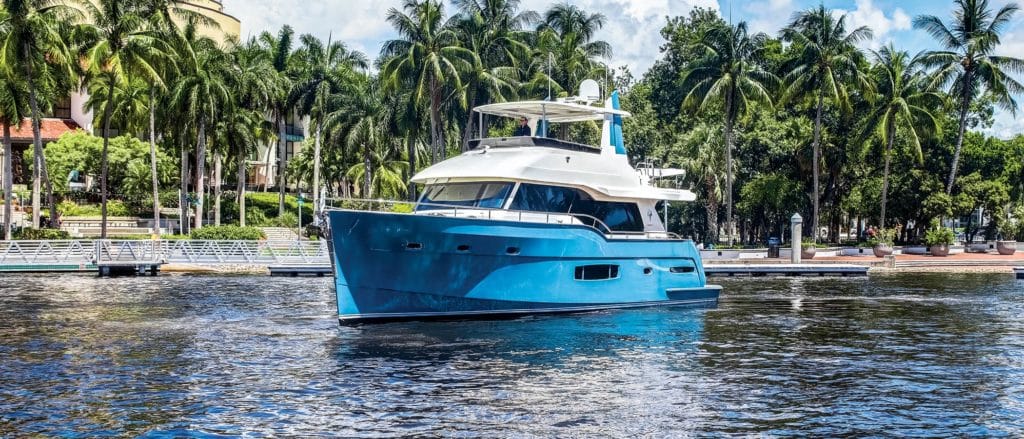
Quick Specifications
| Length Overall: | 61’8” |
| Maximum Beam: | 16’2” |
| Fuel Capacity: | 800 Gal. |
| Freshwater Capacity: | 185 Gal. |
| Draft (straight-shaft): | 4’0” |
| Displacement (half-load): | 51,000 lb. |
Grand Banks 60 Skylounge
It’s obvious after a quick peek inside the Grand Banks 60 Skylounge that the Grand Banks Yachts trademark external DNA is retained. The deck, cabin house and skylounge are all composed of infused carbon fiber, reducing weight aloft and creating a lower center of gravity. With twin 900 hp Volvo Penta D13 diesels, the 60 Skylounge can accelerate to 31 knots and cruise at about 25 knots. The 60 Skylounge can also travel up to 2,000 nautical miles at 10 knots on a 1,530-gallon fuel tank. Twin 1,000 hp Volvo Penta IPS1200s are also available.
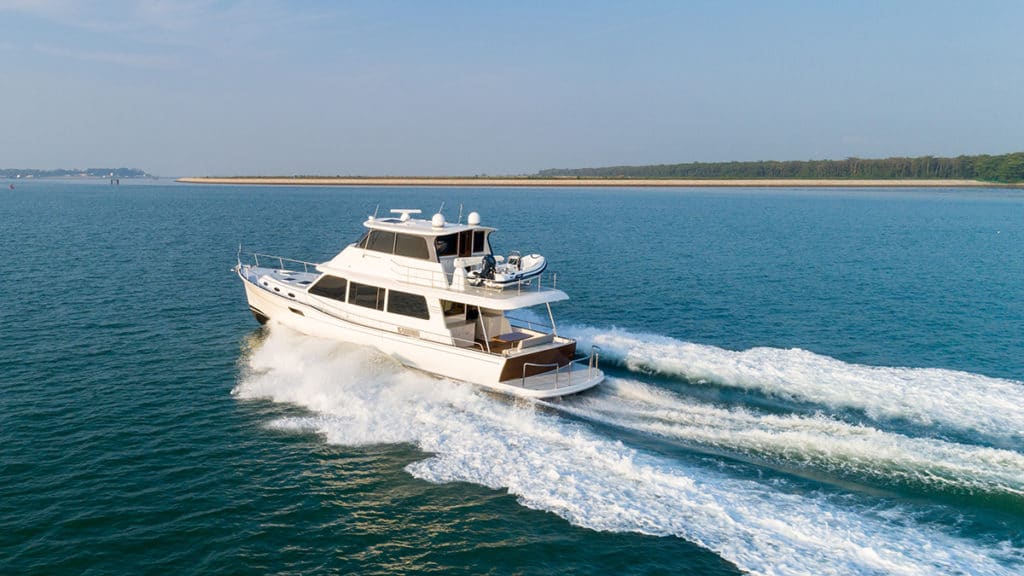
Quick Specifications
| Length Overall: | 66’10” |
| Maximum Beam: | 19’2” |
| Fuel Capacity: | 1,532 Gal. |
| Freshwater Capacity: | 291 Gal. |
| Draft: | 4’3” |
| Displacement: | 62,832 lb. |
Krogen Express 52
The Krogen Express 52 runs on twin 440 hp Yanmar diesels and can cruise at 8 knots for 1,680 nautical miles or at 16 knots for 500 nautical miles. Top hop: 22 knots. In the interior, Krogen Express has outfitted the 52 with a master stateroom and a guest stateroom. The former has a queen island berth, more than 7-foot headroom, hanging lockers and smaller cubbies to port and to starboard, and an en suite head with a molded fiberglass shower stall with a seat, a VacuFlush toilet and a granite countertop. A power lift elevates the berth and grants access to more stowage underneath. The Krogen Express 52’s salon has a 26-inch HD LED TV and a home-theater system, leather Stressless chairs to port and a built-in, L-shape settee to starboard. The galley boasts granite countertops, a three-burner Force 10 propane range with an oven, a refrigerator, a GE microwave oven, a deep Elkay sink and a pullout sprayer faucet. There is a Buff Ultraleather Stidd helm seat for extra comfort during long runs.
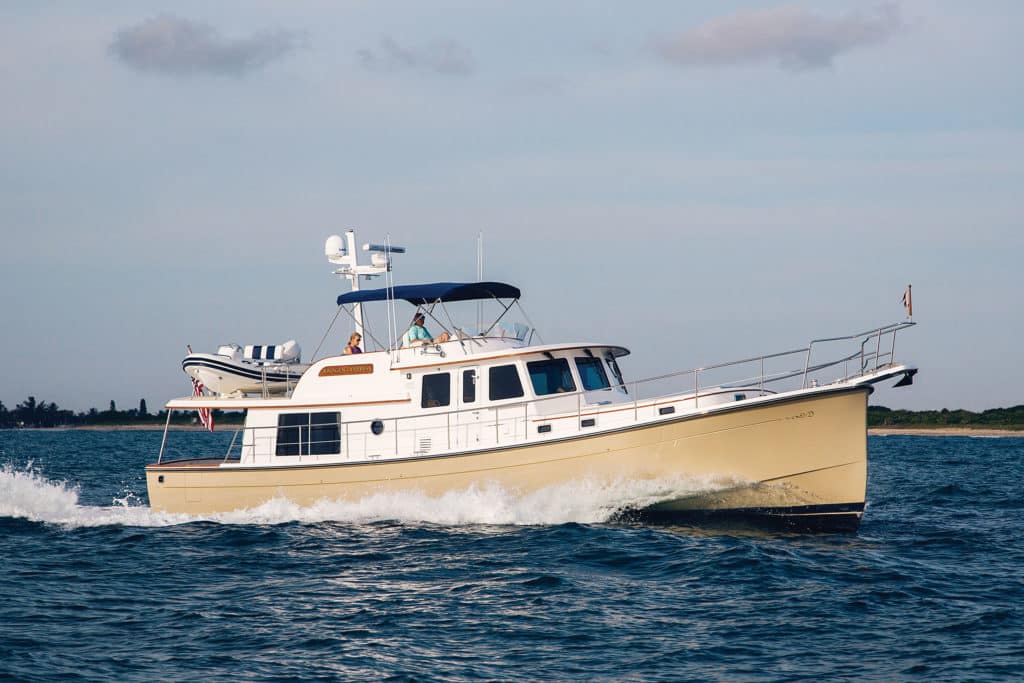
Quick Specifications
| Length Overall: | 57’6” |
| Maximum Beam: | 15’11” |
| Fuel Capacity: | 700 Gal. |
| Freshwater Capacity: | 370 Gal. |
| Draft: | 4’0” |
| Displacement (half-load): | 43,000 lb. |
Grand Banks 85 Skylounge
The Grand Banks 85 Skylounge comes in at more than 87 feet length overall and displaces 108,000 pounds, with a 22-plus-foot beam and an air draft of just under 26 feet. Owners can choose either a three- or four-stateroom layout. The standard motors are twin 1,000 hp Volvo Penta IPS diesels, twin 1,300 hp MAN straight-shaft diesels are optional. With the larger engines, owners can also choose an optional stern thruster, in addition to the standard bow thruster. With the IPS diesels, top speed is 26.5 knots and fuel burn is 100 gallons per hour, resulting in a range of 699 nautical miles. At a 21-knot cruise speed, fuel consumption drops to 57 gph, and range climbs to 972 nm. At a 9-knot jog, fuel burn falls to 9 gph, and the Grand Banks 85 Skylounge can cruise nonstop for about 2,500 nautical miles.
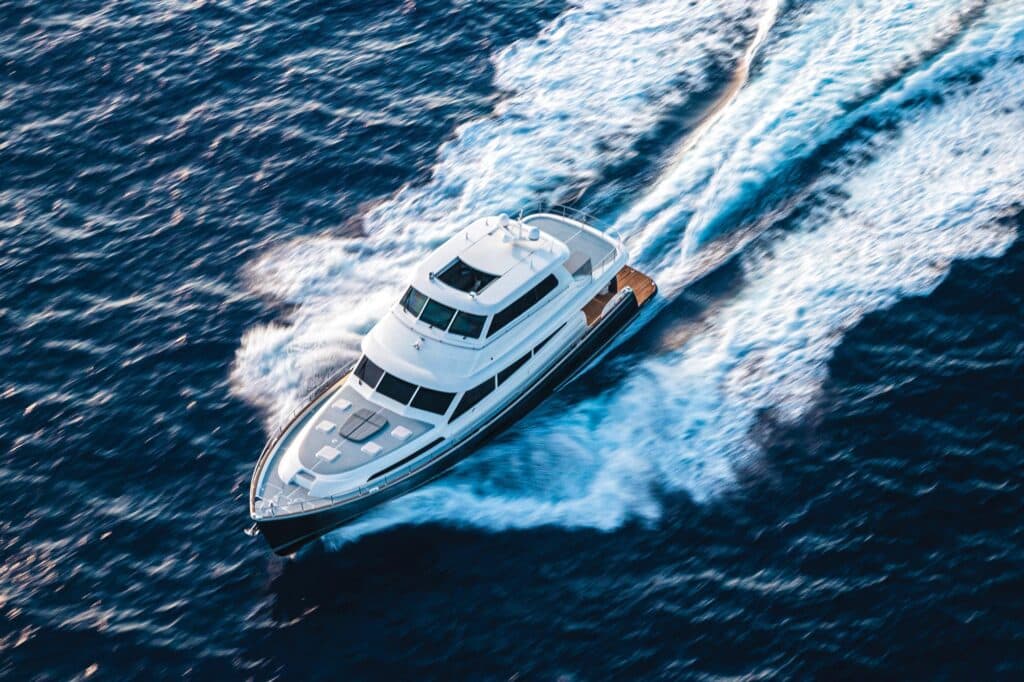
Quick Specifications
| Length Overall: | 87’1” |
| Maximum Beam: | 22’2” |
| Fuel Capacity: | 2,640 Gal. |
| Freshwater Capacity: | 370 Gal. |
| Draft w/ IPS: | 4’11” |
| Displacement: | 108,025 lb. |
Vicem 82 Classic Flybridge
The Vicem 82 Classic is a flybridge model built in cold-molded mahogany, which creates a stout hull form with reduced weight. The yacht is notable for its timeless Downeast lines and strong joiner work. For cruising enthusiasts, the Classic 82 Flybridge is powered with twin 900 hp Volvo Penta D13 diesels. The yacht has a top-end speed of 17.8 knots, and the cruising speed is 15 knots. At 9 knots, and considering a 10-percent fuel reserve, range is reportedly 1,100 nautical miles. Accommodations three en-suite-equipped staterooms. The master stateroom is full-beam and amidships with a king-size berth is on centerline. The starboard-side guest stateroom and a forepeak VIP each have queen-size berths.
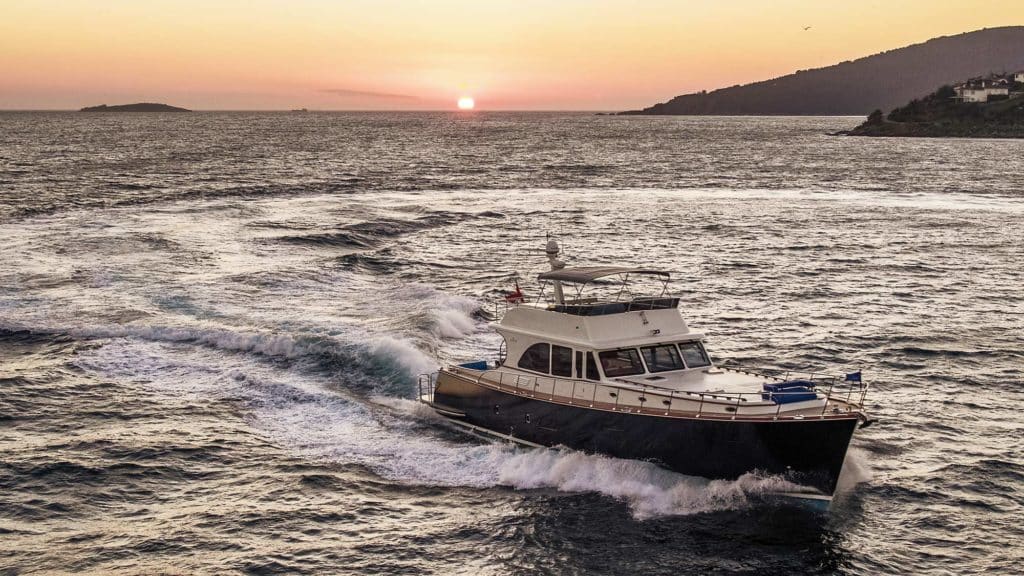
Quick Specifications
| Length Overall: | 81’0” |
| Maximum Beam: | 20’4” |
| Fuel Capacity: | 1,585 Gal. |
| Freshwater Capacity: | 500 Gal. |
| Draft: | 5’3” |
| Cruising Speed: | 10 Knots |
Outer Reef 610 Motoryacht
Built for an enthusiastic cruising couple after a three-year boat search, the Outer Reef Yachts 610 Motoryacht (part of the builder’s Classic series), was customized with a fore-and-aft berth in the owners’ stateroom (as in, not athwartships), and berths rather than bunks in the smaller of two guest staterooms. This Outer Reef 610 was designed to be used as a liveaboard vessel, so the salon is not set up for dining (there are tables in the pilothouse, on the aft deck and on the bridge). A pair of swivel chairs in the salon face the built-in couch and the pop-up TV to port. The 610 is built with hand-laid fiberglass, PVC coring above the waterline, resin infusion and a vinylester barrier coat against osmosis. Power is twin 500 hp John Deere 6090 diesels turning ZF transmissions. The 610 tops out at about 13.5 knots with full tanks and 21 people aboard. The engines burn 20 gph at 1,800 rpm for 11 knots at 45 percent engine load. Those numbers should allow it to cross oceans without shortening engine life.
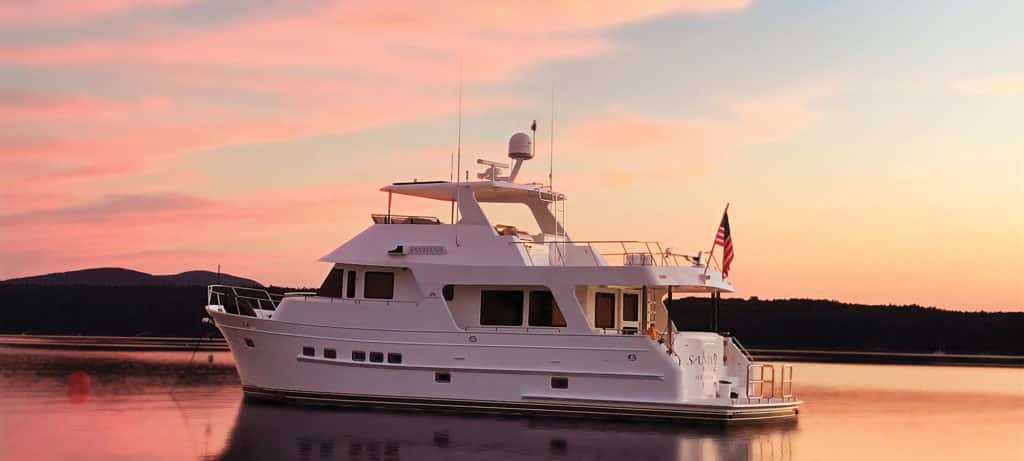
Quick Specifications
| Length Overall: | 61’2” |
| Maximum Beam: | 17’2” |
| Fuel Capacity: | 1,000 Gal. |
| Freshwater Capacity: | 300 Gal. |
| Draft: | 5’0” |
| Displacement: | 93,000 lb. |
Nordhavn 59 Coastal Pilot
Nordhavn has long been known for its stout circumnavigation-capable craft, and the Nordhavn 59 Coastal Pilot carries on the the tradition of a beefy build with addition of…speed. Twenty-knots-plus, actually. Twin 715 hp Cummins diesel inboards and a new semidisplacement hull form are said to be key to the performance equation. The Nordhavn 59CP has a 777-nautical-mile range at a 9.3-knot cruise, and a 255-nm range at its 20.3-knot top-end. Construction is a solid fiberglass hull bottom supported by full-length longitudinal stringers and a series of transversal supports for added backbone. High freeboard should keep the decks dry in a seaway, while rails keep the crew secure during transits. Nordhavn says the 59CP has a “CE category A unlimited offshore rating, ensuring the vessel has the seakeeping and strength capabilities to take on most serious coastal cruises up to 1,000 miles.”
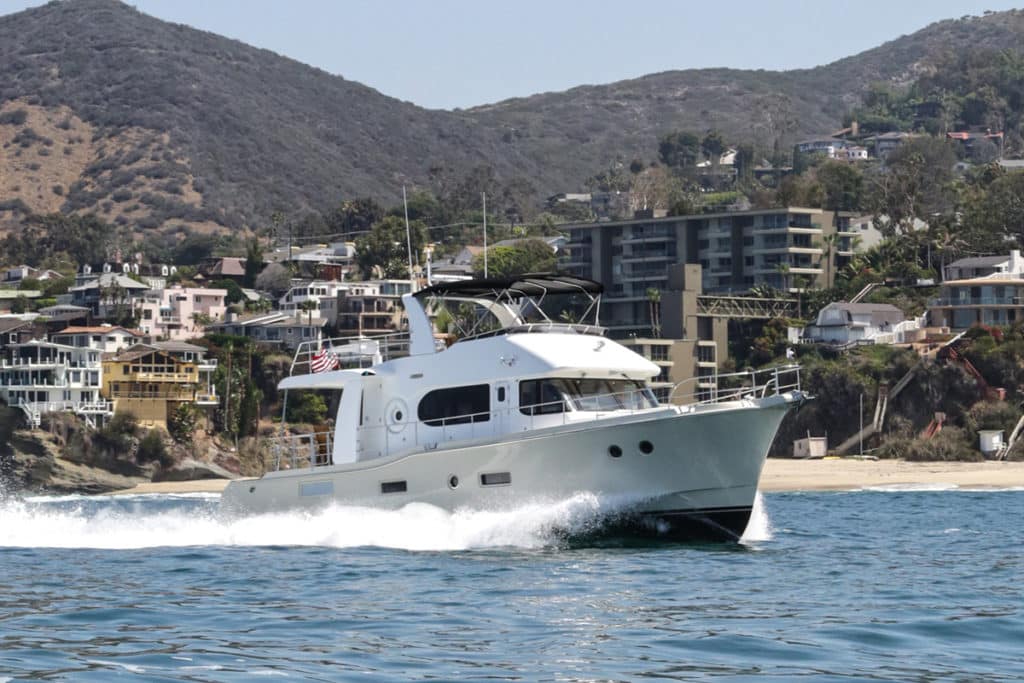
Quick Specifications
| Length Overall: | 58’10” |
| Maximum Beam: | 17’0” |
| Fuel Capacity: | 1,100 Gal. |
| Freshwater Capacity: | 444 Gal. |
| Draft: | 5’0” |
| Displacement: | 88,000 lb. |
Marlow Yachts 58E
Following on the successful Marlow 57, the Marlow 58E was started from scratch on a blank sheet of paper. The essence of the 58E is that it has better performance and more internal and external volume than her predecessor. The centerline length grew 10 inches over the 57, but the waterline length increased 16 inches and the beam widened 4 inches. If you were to examine the two boats out of the water, you would see more bell-shaped forward sections making for a soft impact with the vee’d portion. Power options start with twin 575 hp Caterpillar C9 diesels, but the 58E we got aboard had beefier twin 1,015 hp Caterpillar C18 diesels. Top speed: 27.9 knots. At 8 knots, the Marlow 58E can cruise nonstop for 1,400 nautical miles.
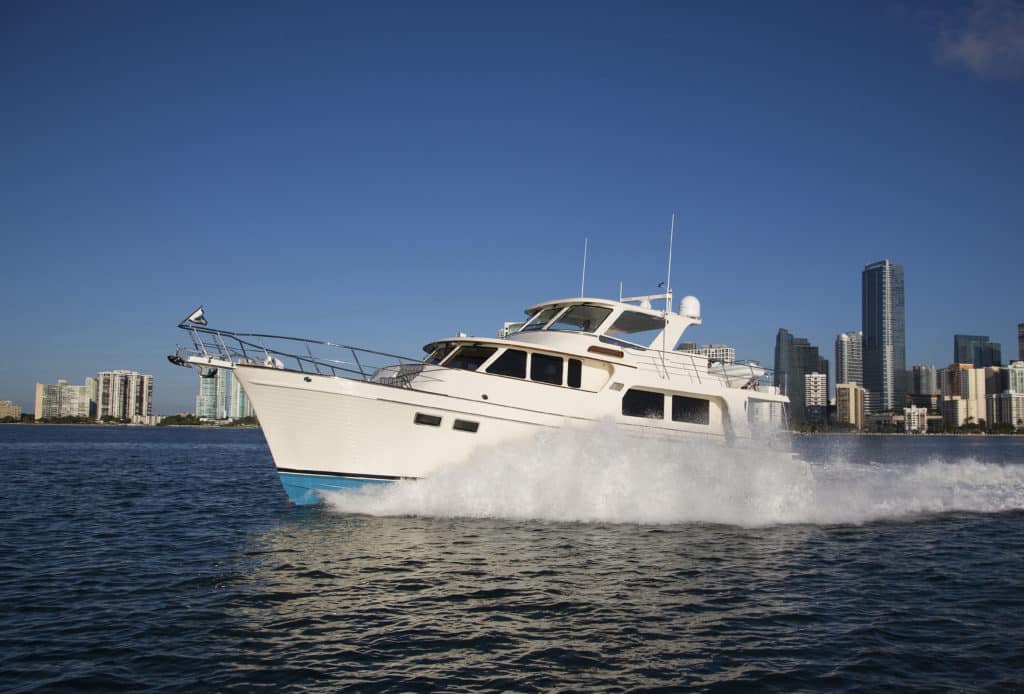
Quick Specifications
| Length Overall: | 67’8” |
| Maximum Beam: | 18’6” |
| Fuel Capacity: | 1,500 Gal. |
| Freshwater Capacity: | 300 Gal. |
| Draft: | 4’10” |
| Displacement: | 69,000 lb. |
Frequently Asked Questions:
What is a trawler yacht?
A true trawler typically has a full-displacement hull form and robust construction to handle open-water operation, and it’s designed to operate self-sufficiently for long periods of time. They are slow-cruising vessels, but over the years, hybrid yachts called fast trawlers have emerged to offer displacement-speed operation as well as the ability to run at planing speeds when desired.
What is a full-displacement hull form?
A displacement-hull form is known is for its rounded nature and deep draft. Full-displacement vessels do not plane on the water, but rather push through the water. This hull design makes displacement-hull vessels incredibly seakindly, but it also makes them relatively slow (think 5, 6, 7, 8 knots) when compared to semidisplacement- and planning-hull designs.
Is a long-range cruiser the same as a trawler?
While all trawlers are certainly long-range cruisers, not all long-range cruisers are trawlers. True trawlers will have full-displacement hull designs and not all long-range cruisers have them.
The post Top 15 Trawlers for 2023 appeared first on Yachting.
]]>The post Building Bluewater Cruising Yachts appeared first on Yachting.
]]>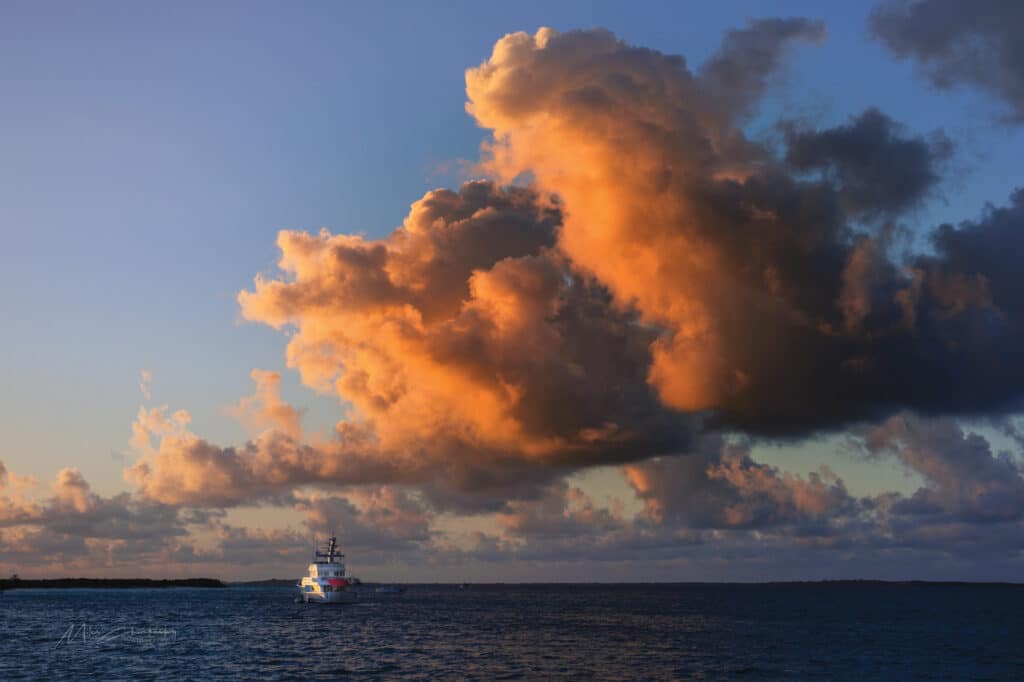
If Mother Nature had been less obstinate, Miles Cherkasky might have continued to sail.
“I’ve been sailing since I was probably 14 years old, almost half a century of sailing,” he says, now in his 60s. “One day, I was doing a delivery from Baltimore down to Miami Beach where we have a slip, and there was no wind, and I was sitting there listening to my engine run, and I couldn’t go anywhere, and I thought, ‘This is stupid. Time to get a trawler.’”
But what kind of trawler? He and his wife, Laureen, knew they liked longer-distance, offshore cruising—after Miles retired back in 2007, they bought a 47-foot high-performance sailboat and cruised it from Nova Scotia to the Bahamas a few times—but they weren’t quite sure how to achieve a good cruising experience in a powerboat. That is, until the day Miles helped with the delivery of an Outer Reef.
“When they came out of the inlet, Miles was putting away his cup of coffee, getting ready, thinking there were going to be all these waves and it would be sloppy, but nobody around him was moving or getting prepared for these big seas,” Laureen recalls. “The ride was like glass. When he came home that day, he said, ‘We have to get an Outer Reef.’”
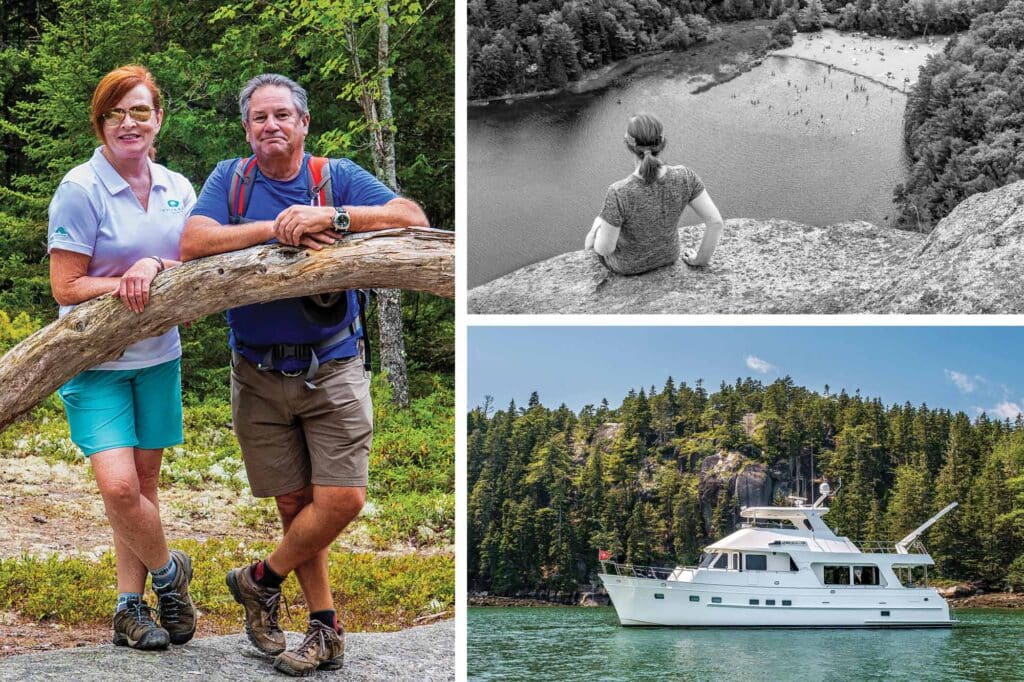
Just like that, the Cherkaskys became members of a club that has grown almost exponentially in recent years, as an increasing number of boaters realize they can live their long-distance cruising dreams with the kinds of creature comforts that used to be limited to land. Today’s offshore-capable power yachts for cruising couples and families, built by companies such as Outer Reef, Nordhavn and Kadey-Krogen, are being built for go-anywhere adventure. They’re also being outfitted for the specific types of adventures that owners want to undertake.
“These boats are not marina queens,” says Jeff Druek, president and CEO of Outer Reef. “We talk a lot about equipment on board, things like inverters, solar panels, how many generators, what size generators, what type of air conditioning—things of that nature. Every piece of equipment in the boat is talked about, in terms of how they plan to use their boat, how far they’re going to go afield, how long they’re going to be away from the dock and where they’re going to be cruising.”
“I’m at the point now where I don’t have to do the five- or six-day-a-week grind, and that allows the flexibility to travel a bit farther.”
— John Ellis, Owner, Nordhavn 68 “Dragon”
Nordhavn President Dan Streech says the way today’s bluewater hulls are being built and outfitted is making adventure cruising a real option for people who just a couple of decades ago would have feared it. The kinds of discomfort and danger that used to be part and parcel of crossing oceans are now minimized by modern construction, communication tools and redundant systems, so much so that all kinds of people feel comfortable cruising far and wide.
“You’re seeing normal people who in no way would’ve been sailboat material 35 years ago,” Streech says. “They have the chart plotters and Starlink. They’re sitting on the open ocean doing Facetime with their grandchildren. They’re not disconnecting from the world. It’s not necessary to have physical sacrifices or the emotional trauma of cutting themselves off. They have washers and dryers, wine coolers, TV, communication as they’re heading down to the South Pacific, and they are part of a huge social network, even just inside the Nordhavn world. We have 600 boats. The owners’ group—there are probably 20, 30, 40 posts a day with people who have a question. That feeling of isolation is gone.”
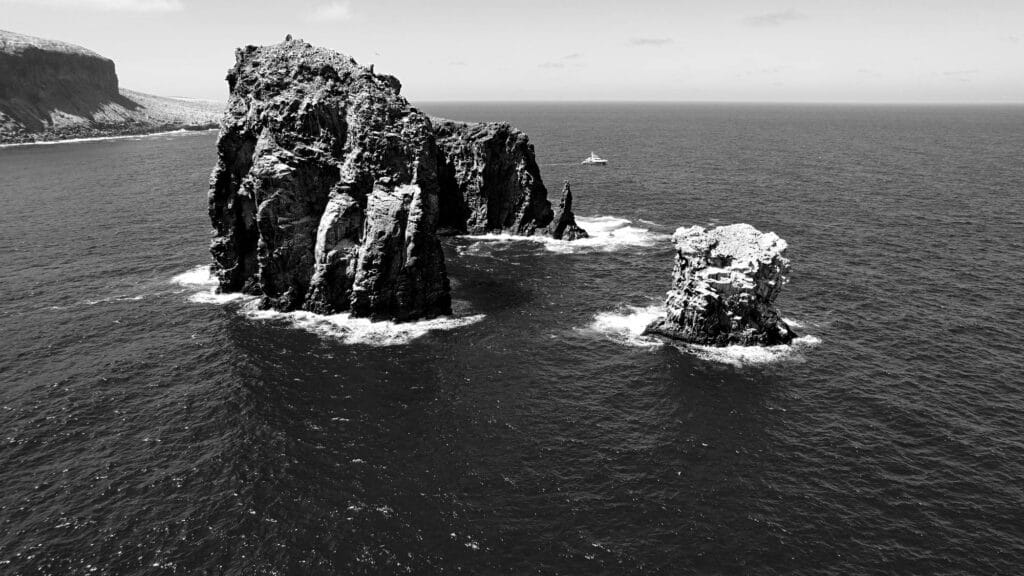
John Ellis took delivery of his Nordhavn 68, Dragon, in 2021 with a vision of following in his parents’ wake, only in a less-stressful way.
“I have a lot of sailing experience. My parents were cruisers,” Ellis says. “I spent time on board with them in the South Pacific. I’ve been on long passages with slanted decks. That wasn’t really what I was looking for. I loved those years—they were wonderful—but I’m looking for a different experience.”
A big part of the offshore powerboat experience for Ellis is fishing, so he customized his Nordhavn with extra bait tanks and rod stowage, along with two Seakeepers: an SK9 and an SK16. “When we stop and we’re fishing in the open ocean, we need to keep the motion down on the boat,” Ellis says. “The ocean has a tendency to want to rearrange the furniture on these big boats. Now, we tap a button, and it’s just as solid and stable as it can be. Nobody’s mad at me, and nothing’s breaking. No plates are crashing inside.”
That change in the way bluewater boats are built, Streech says, is also changing the profile of offshore cruisers. Back in the day, the typical Nordhavn customer was a husband who wanted to point the bow offshore and a wife being dragged along for the white-knuckle ride. Not so today, Streech says: “Just a shower alone was a luxury 35 years ago, and now you’re standing in a stone shower with gorgeous fixtures and a heated towel bar. What we’re seeing more and more is teamwork. A couple comes in, and she’s not looking at her phone half-mad because they just had a fight in the car. Not at all. She’s right there on the team and leading it sometimes. She has deduced that this is a path where they can share something, have an adventure and travel the world.”
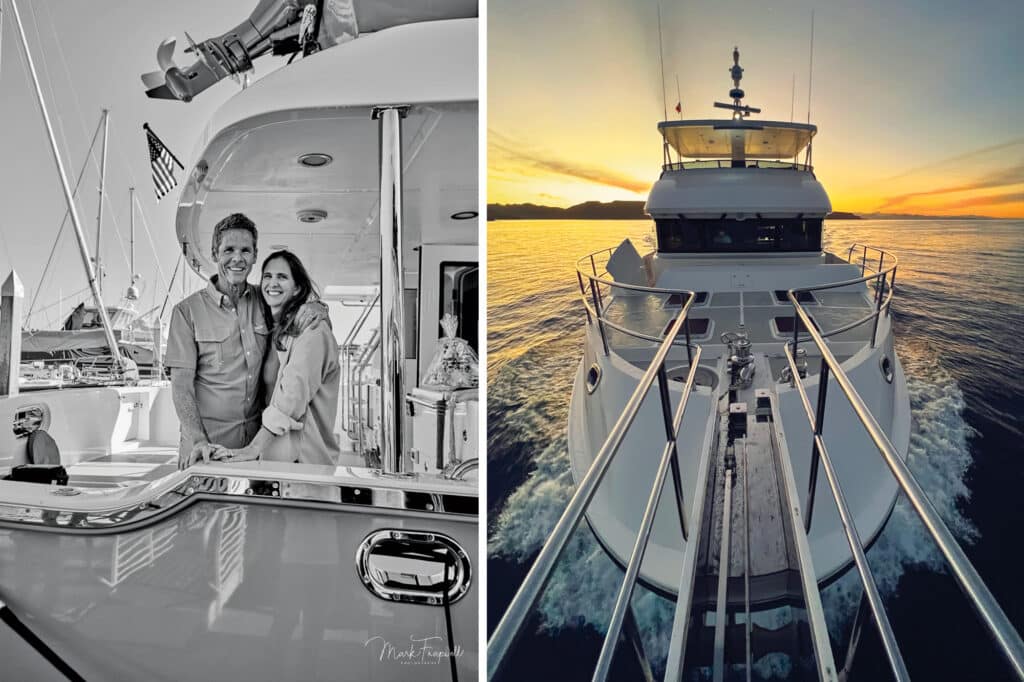
Ellis says that’s exactly the plan that he and his wife share, now that both their kids are off to college. Their intent is to complete a 10-year circumnavigation.
“We’re going to go to the Caribbean and then come up the Eastern Seaboard, then go up to Nova Scotia, then back down to Florida after hurricane season next year, then Bermuda to the Azores, then get to Portugal and figure out whether we want to go up the Thames for fish and chips or whether we want to go around the corner to France,” he says. “It’s inevitable that we’re going to do both. My wife wants to do all the things, and we’re super happy with all the confidence we’ve been able to build aboard the boat so far.”
Sandy Peretsman says it was actually his wife’s idea to buy the Kadey-Krogen 48 that they named Third Child. She’s still winding down her career, but he retired this past January and started thinking harder about what comes next. They’d always had smaller boats and chartered larger ones in destinations such as the British Virgin Islands; he wanted them to have a bluewater-capable boat of their own, one that would let them do more as owner-operators. “My wife pushed me to do this a few years ago when I was turning 60,” Peretsman recalls, adding that his wife told him, “You don’t want to be one of those people who say, ‘I’m going to do it,’ and you don’t.”
So, they’re doing it. They base Third Child out of Charleston, South Carolina. So far, they’ve gone as far south as the Bahamas, and they’re thinking about heading up to New England, as well as cruising farther south into the Caribbean, as they become more comfortable aboard. “You can island-hop your way all the way to the Virgin Islands without ever driving more than 200 miles at a time, and we already drive that along the East Coast,” he says. “My personal preference is offshore because there’s a lot less traffic. It’s more relaxing. You don’t have to worry about how deep the ocean is or running aground, or boats passing you and crossing you. It’s just a big, blue patch, so you can go where you want, as you want.”
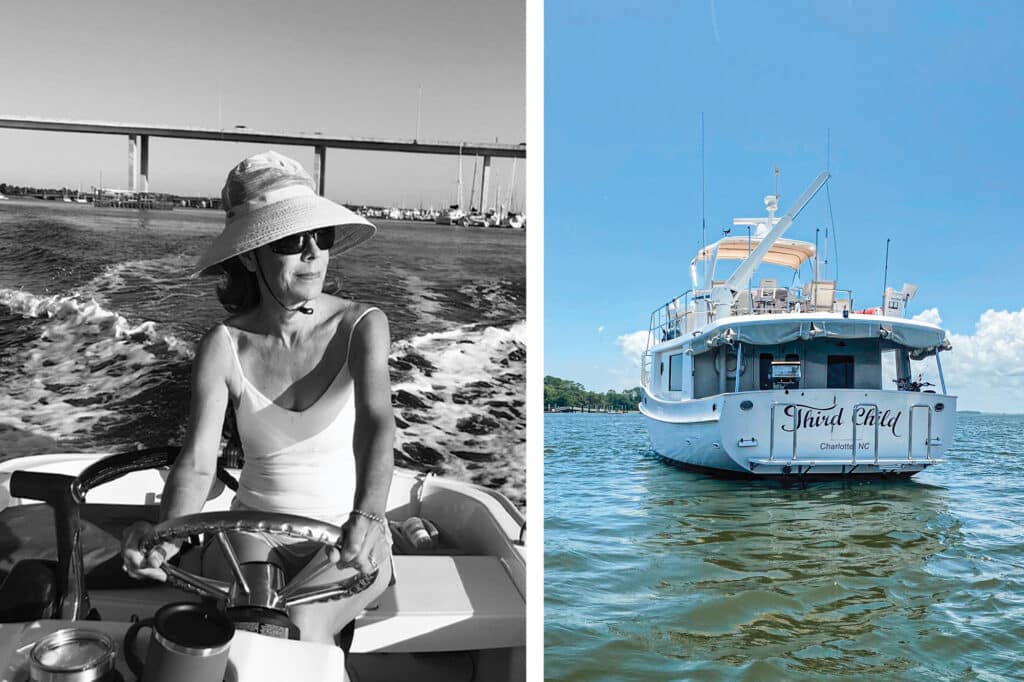
The more time he spends running his Kadey-Krogen, Peretsman says, the more he’s thinking about increasing his cruising distances. “I can go from Charleston to Europe and most of the way back on one tank of gas,” he says. “These boats will go 4,000 or 5,000 miles on a single tank of fuel. It doesn’t suit everybody, but if you want to be out there, it’s a wonderful boat for it.”
Streech says that for Nordhavn owners, ocean crossings aren’t even big news anymore. The company has had 13 boats complete circumnavigations so far; one of them did it three times. Over at Outer Reef, Druek says, so many people want to cruise off the beaten track that the resale value of the bluewater-capable boats stays high. Some of them, he says, he’s resold eight or 10 times.
It’s a testament to how far powerboat building has come that adventures so impressive are increasingly common. “To the Marquesas, that’s 3,000 miles,” Streech says. “It’s shocking, it’s mind-numbing that if you looked down from an airplane, you probably couldn’t even see the boat, and these boats make it. They do it over and over and over again.”
The Core Elements
Nordhavn President Dan Streech says that for distance cruising, “there are basics that have to be adhered to in terms of stability, structure, fuel capacity, fuel handling. All those things need to be there. They don’t get talked about that much anymore. They’re a given for us now at Nordhavn.”
Having It All on Board
Production Manager Fran Morey says Kadey-Krogen owners typically stay on board at least six months each year. “They want everything that’s the latest and greatest, and they also want the creature comforts of home,” he says.
The post Building Bluewater Cruising Yachts appeared first on Yachting.
]]>The post Price Drop on Krogen 42 appeared first on Yachting.
]]>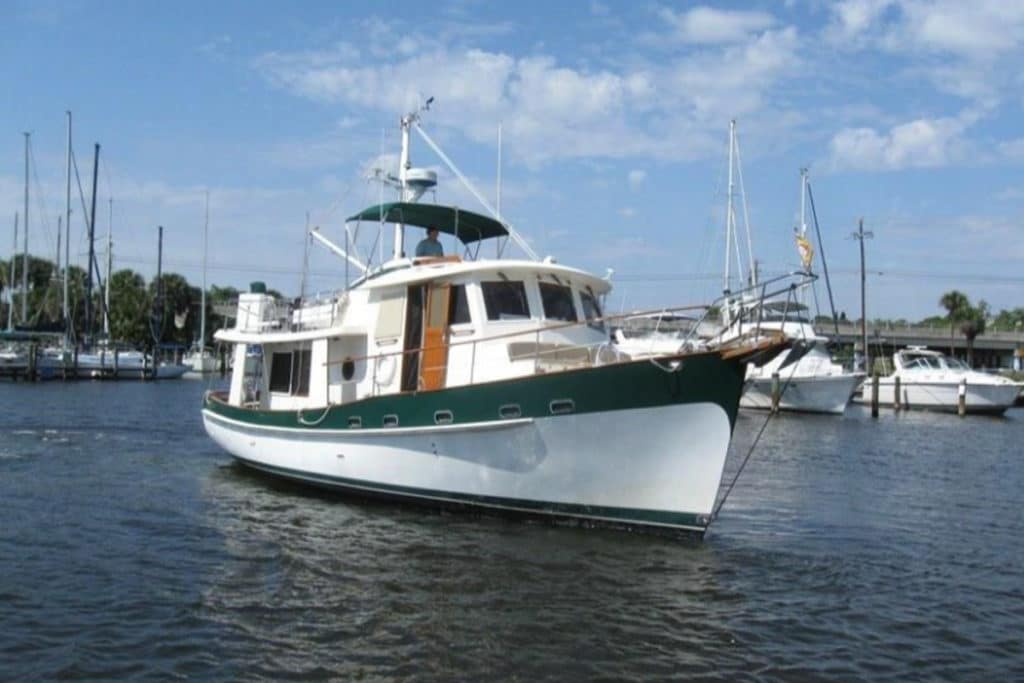
Kadey-Krogen says there has been a $40,000 price drop on the 1987 Krogen 42 Bonnie Dawn. The current asking price is $199,000.
Bonnie Dawn is a two-stateroom, two-head boat that has Naiad hydraulic stabilizers. The most recent servicing was done in May 2022, and the engines are showing 700 hours SMOH (since major overhaul).
Recent improvements include the addition of stern and bow thrusters, new aluminum starboard fuel tanks, upgraded pilothouse and flybridge electronics, new Sunbrella canvas, solar panels and fresh varnish.
Where is Bonnie Dawn available for tours? The yacht is lying in Stuart, Florida.
Take the next step: contact a sales broker at kadeykrogen.com
The post Price Drop on Krogen 42 appeared first on Yachting.
]]>The post Reaching the Summit appeared first on Yachting.
]]>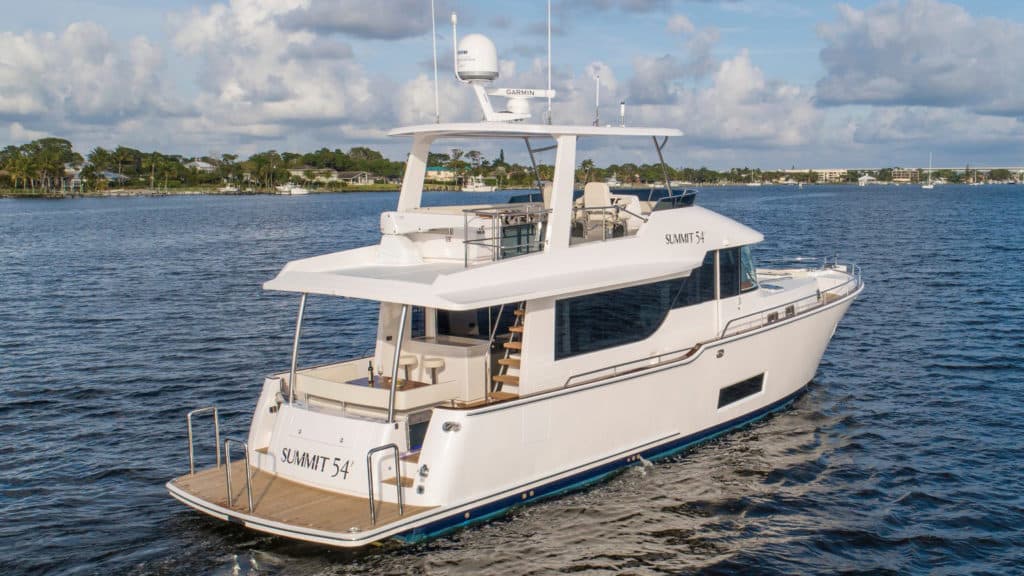
They are known for their full-displacement, semicustom, liveaboard trawler yachts. So when iconic builders Kadey-Krogen decided to expand their offerings with a planing-hull model, they brought on noted performance-cruiser designer and naval architect Michael Peters, and the Summit Motoryacht concept was born.
The idea was to expand the reach of the 45-plus-year-old brand and step into the coastal-cruiser segment of the market with an innovative and solid design. It would take advantage of the Kadey-Krogen build quality, thoughtful details and engineering, but would otherwise retain its own identity under the Summit Motoryachts umbrella.
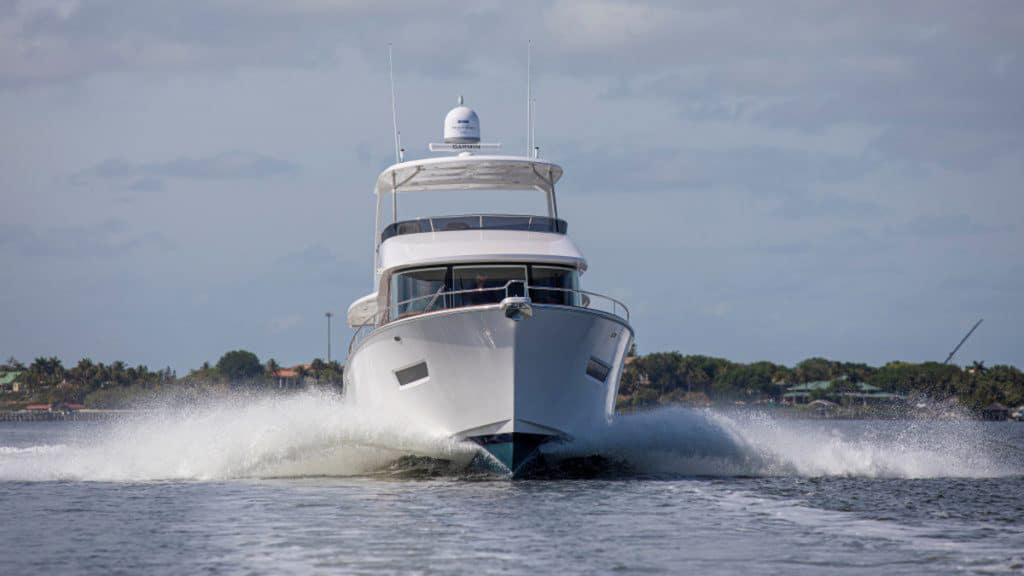
“Most brands have a major hull form that they apply across the range of boats they do,” Peters says. “But Kadey-Krogen knew that the best way to meet this new market sector was to design a proper performance-cruiser hull. We considered the hull form that was best suited to the concept and created a hard-chine boat with a moderate deadrise as opposed to a deep-V hull. We were also careful to balance both ends of the boat—not too fine forward and not too flat aft.”
The result is the inherently stable Summit Motoryacht, a shaft-drive cruiser powered by twin 542 hp Cummins QSB6.7 engines matched to ZF transmissions, affording a 25-knot top speed and an enviable 3-foot-7-inch draft. The first model in the Series—the Summit 54 MY—reaches a planing speed of 20 knots in 10 seconds and boasts a 330 nm range at 23 knots.
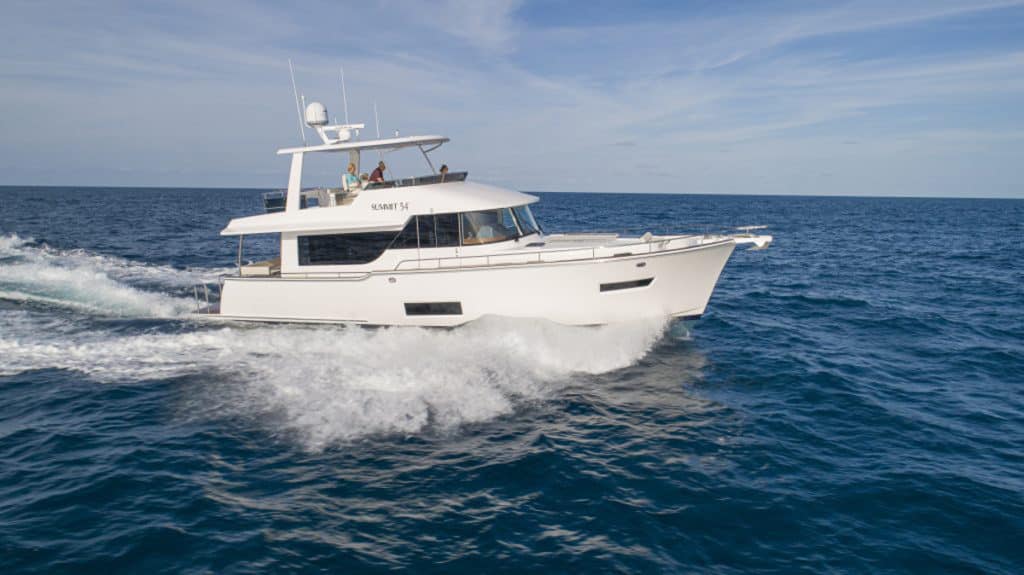
Balanced Design
The collaboration for the first Summit Motoryacht drew on the expertise of Kadey-Krogen’s engineering team and the advice of company president and CEO Tucker West, whose decade-long tenure with the brand was preceded by years of experience with performance-cruiser builder Grand Banks Yachts.
“The Summit Motoryacht line is intended to appeal to today’s boating family and has been designed for that purpose,” West says. “The thoughtful design offers families a flexible stateroom layout, open indoor/outdoor main-deck level, multiple relaxation areas on the decks, and a comfortable, stable ride.”
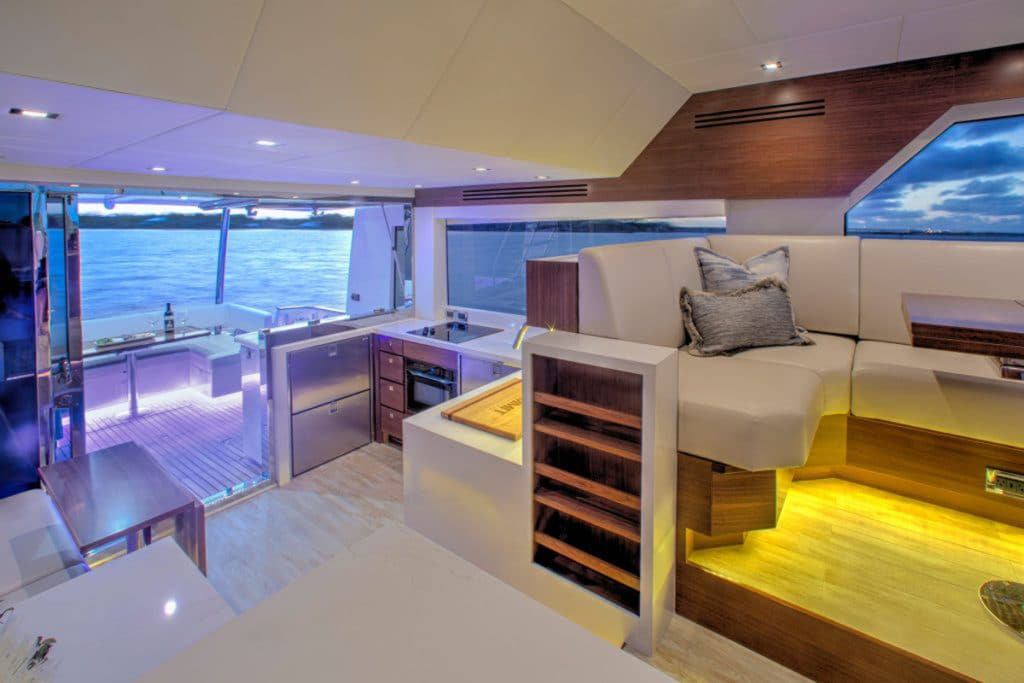
A spacious open flybridge and large windows affording 360-degree views characterize the exterior profile of the Summit 54, and lend a modern touch to the recognizable performance-cruiser design.
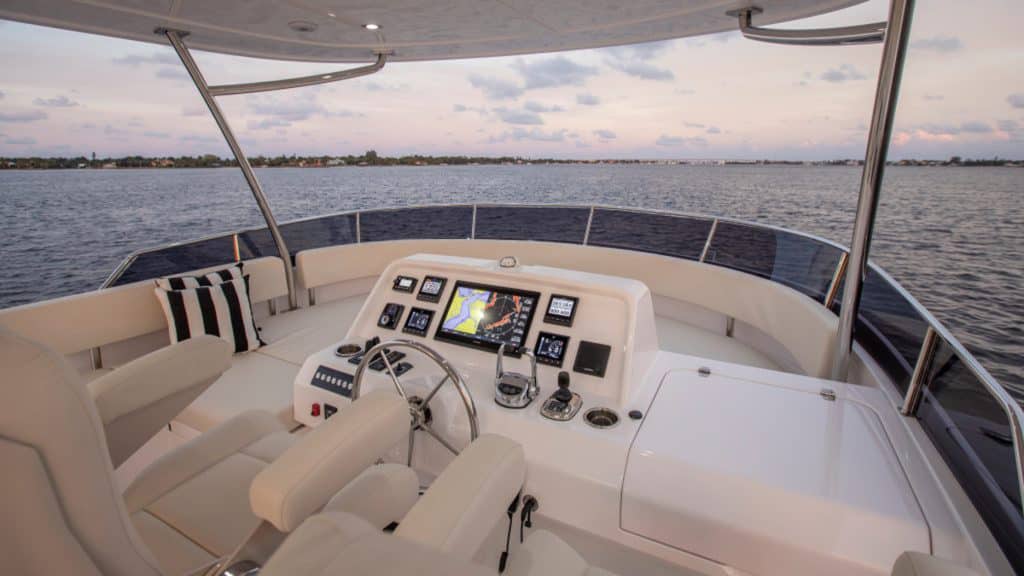
Indoor/Outdoor Living
The functionality of the Summit 54’s design begins at deck level, where the aft deck—protected by the extended flybridge hardtop—provides an inviting indoor/outdoor space highlighted by a U-shaped settee with a dining table and a bar counter with two bar stools. A folding glass door opens to the interior, which sees the galley positioned aft so as to easily access both indoor and exterior areas. Here, a fold-up window further integrates the galley with the aft deck and bar area for ease of service. The thoughtful details continue with a built-in blender motor in the bar counter for frozen beverages at the ready.
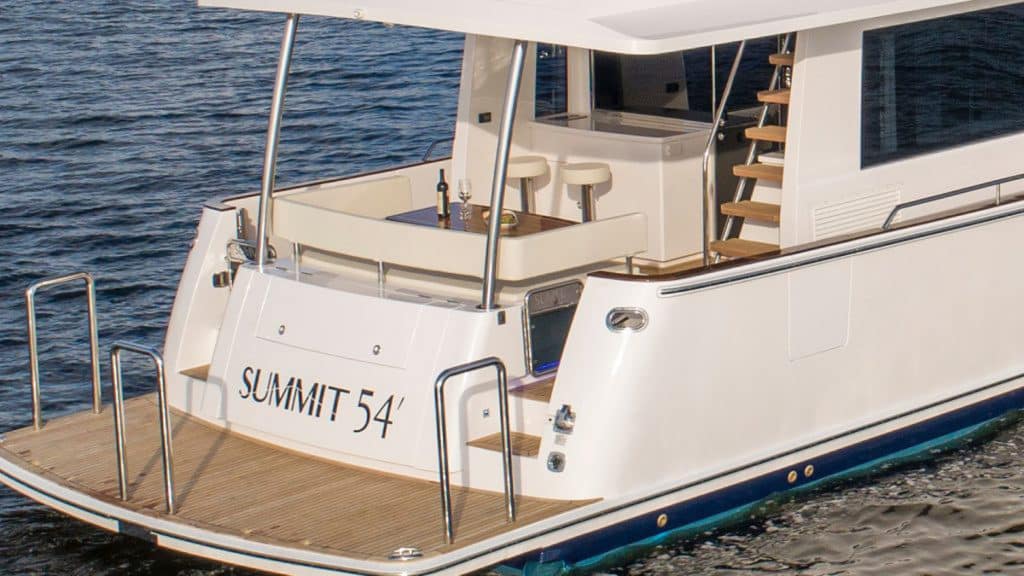
Considering the needs of family boaters, the Summit design team created a pull-out electric-grill area in the transom, which features a beverage holder, lighting, and dedicated storage for grill supplies. Positioning the barbecue at this level is much more functional, West explains, than situating it on the flybridge, away from the galley and aft deck dining area, which would require carrying the food, supplies, and equipment up and down the flybridge steps.
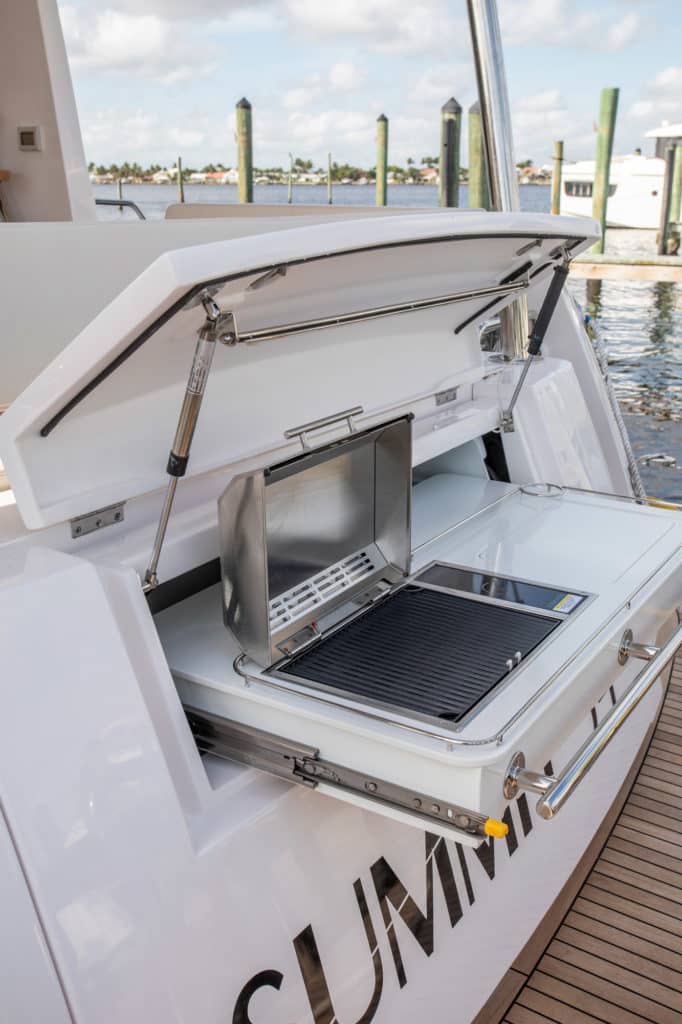
The transom itself offers storage for equipment and water toys. In fact, storage is a major consideration throughout, and is one of the signature elements borrowed from the Kadey-Krogen liveaboard design.
Walkaround teak side decks with teak-capped rails lead from the transom to the foredeck area, which is fitted with a large reclining sun pad that can be shaded by a sun awning.
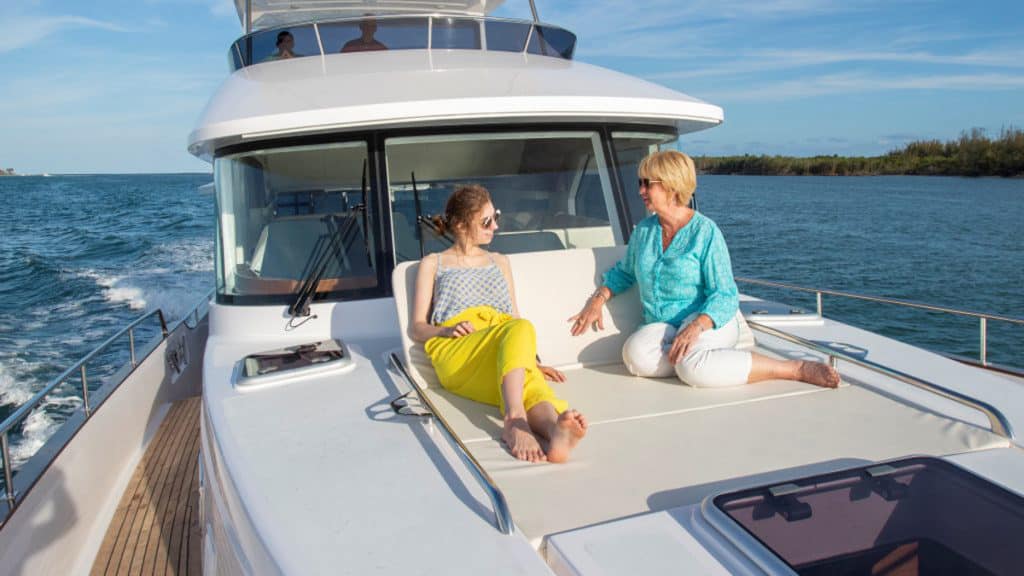
The alfresco living continues on the spacious flybridge, in which the designers created a unique wraparound sun pad area forward of the helm. This space features a fully equipped helm with Garmin display on centerline, a refrigerator, additional seating with built-in storage, and a hardtop fitted with speakers and LED lighting. Aft, the wide-open boat deck can hold a 10-foot-6-inch tender launched by a 1,000-pound davit. Alternatively, the tender can be stored on the swim platform to allow for additional functionality of the boat deck.
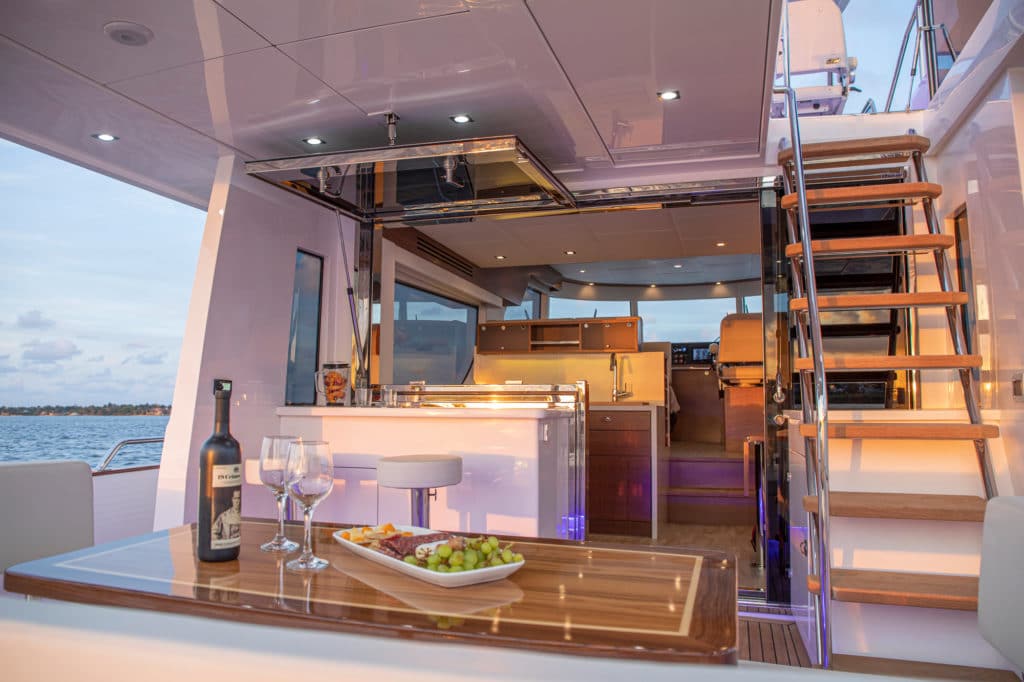
Modern Interior
Architectural interior designer J.C. Espinosa lent his expertise to the interior design and layout of the Summit line, resulting in a contemporary design aesthetic that meets the space planning and functionality desired in a performance cruiser.
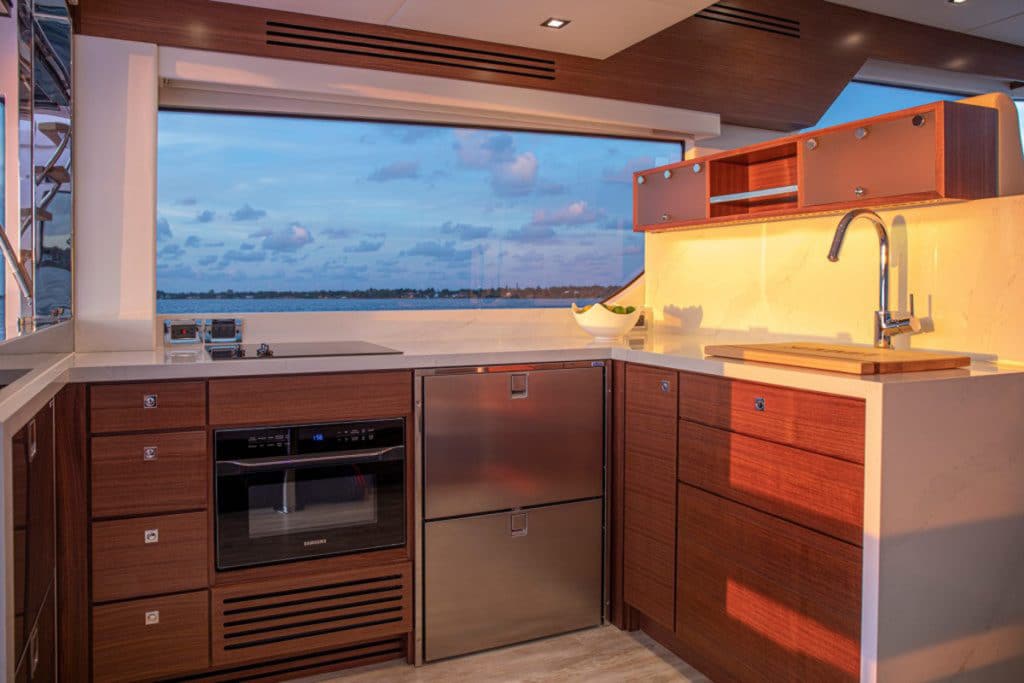
The yacht’s huge windows bring plentiful natural light into the interior while also providing pleasant sightlines from the seating areas throughout. The aft galley is outfitted with Silestone countertops, a cooktop, refrigerator/freezer drawers and a pull-out dishwasher. Storage is maximized throughout and includes overhead cabinetry as well as an ingenious pop-up appliance dock built into the counter.
The raised main salon and helm area presents another comfortable living space, and the entire interior can be customized with a soft good and finishes package of the client’s choosing, the standard being satin walnut with Amtico sole, with teak an option. The comfortable salon area features a settee and table with extendable leaves opposite a pop-up flat-screen television, while the fully equipped helm station with twin ultra-leather helm chairs is positioned forward on the starboard side. A door to starboard of the helm area provides increased visibility for the captain.
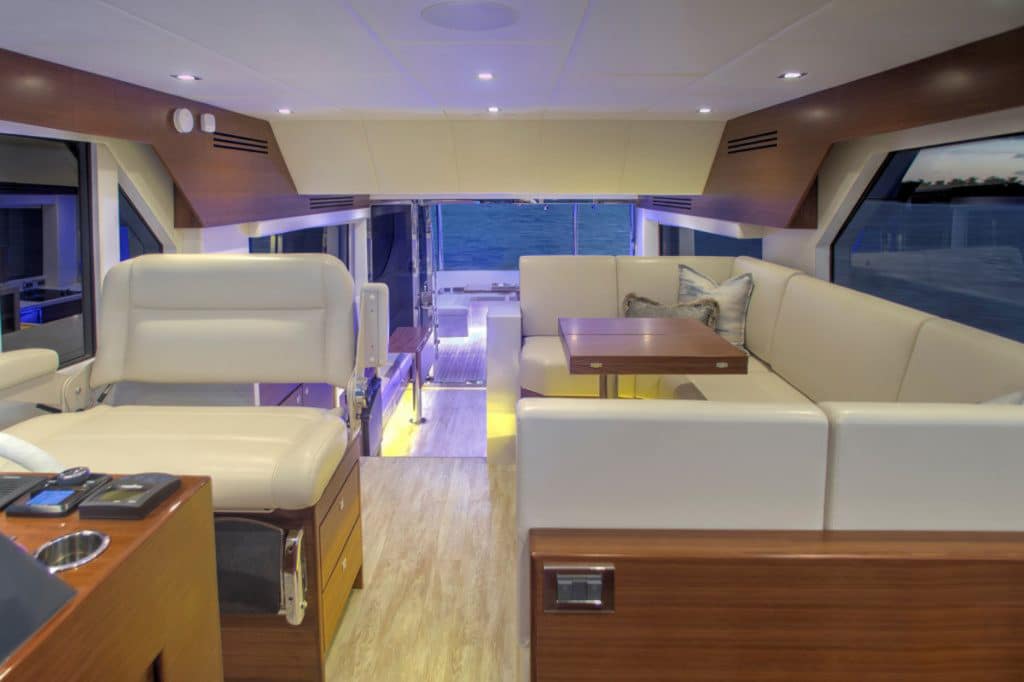
A CZone Control and Monitoring system manages the electric and entertainment throughout. The engines are managed by Cummins SmartCraft controls, while joystick and wireless remote docking systems are also available. The Zipwake Dynamic Trim-Control System provides interceptor-style trim tabs, aiding in the onboard comfort and fuel economy of this efficient vessel.
The Summit 54 offers a flexible three-stateroom, two-head layout, with the master stateroom positioned amidships, and a queen-size VIP in the bow on the lower deck. The third cabin houses a full-size stacked washer/dryer unit and can be set up with a single or bunk beds, or can be configured as an office with a convertible settee. Soundown sound-dampening insulation minimizes vibration throughout.
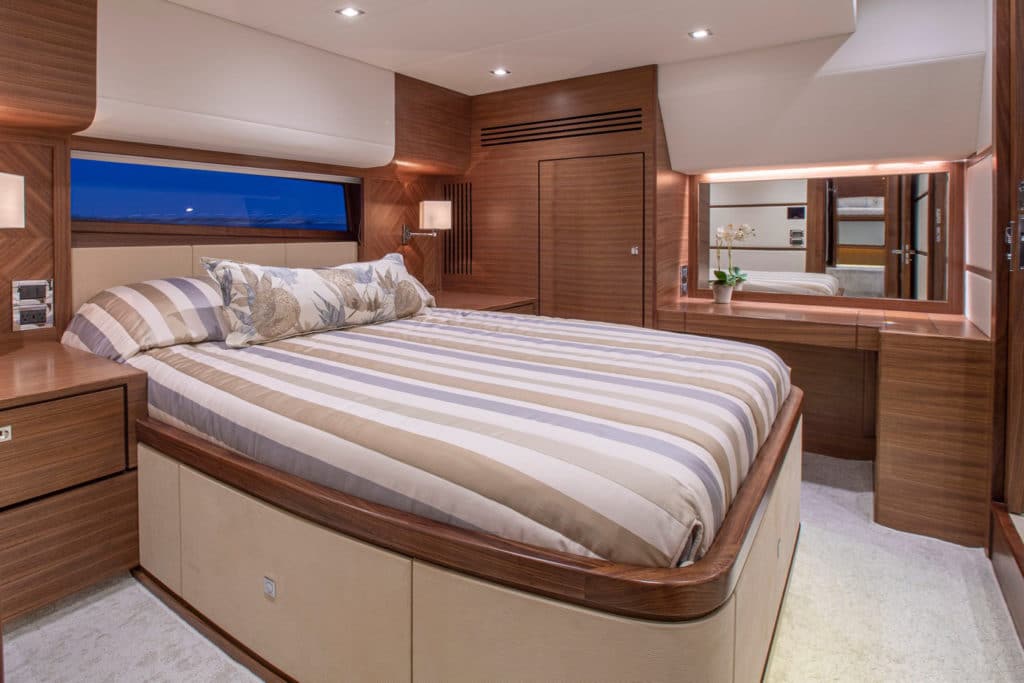
Once again, the liveaboard experience of Kadey-Krogen extends into the Summit 54’s accommodations, where copious storage includes multiple hanging lockers and optimized spaces normally kept void on other vessels. In the master, a split en suite adds to the functionality, with both the water closet and shower opposite kept private behind smoked opaque doors.
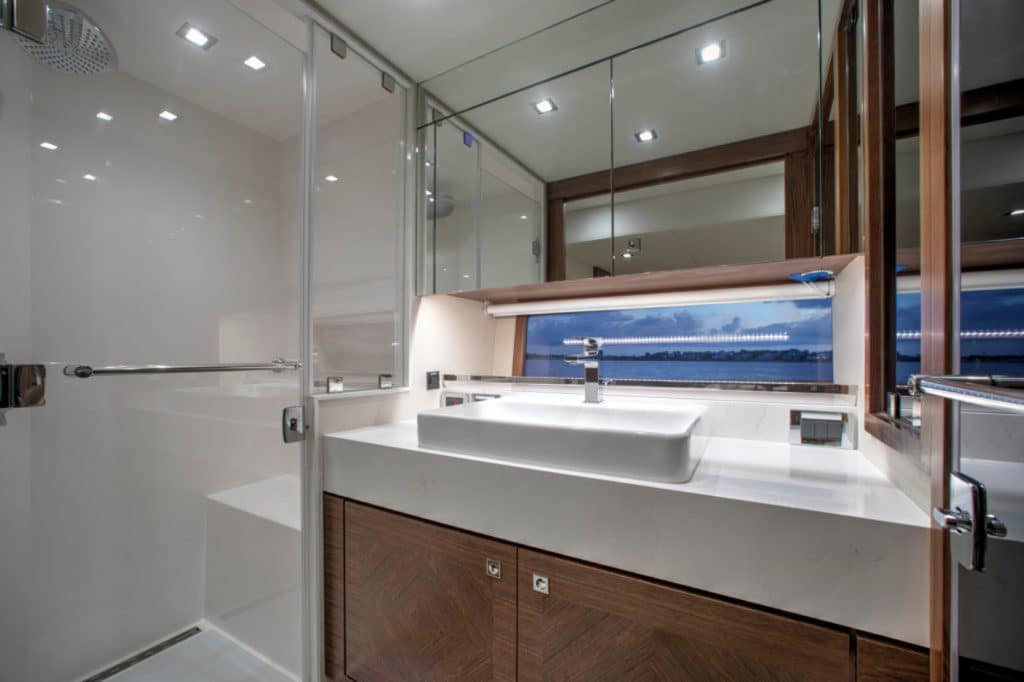
The Summit Motoryacht line is designed to suit the boater who prefers long weekend coastal cruising with the family, with the option and livability designed for longer excursions. The introduction of the first Summit 54 in March 2020 was hampered by the COVID-19 pandemic, but interested clients responded, and Hull No. 4 is now under construction. Following behind the 54 MY is a new Summit 54 Coupe express boat version that features an opening sunroof, and then a 62 MY.
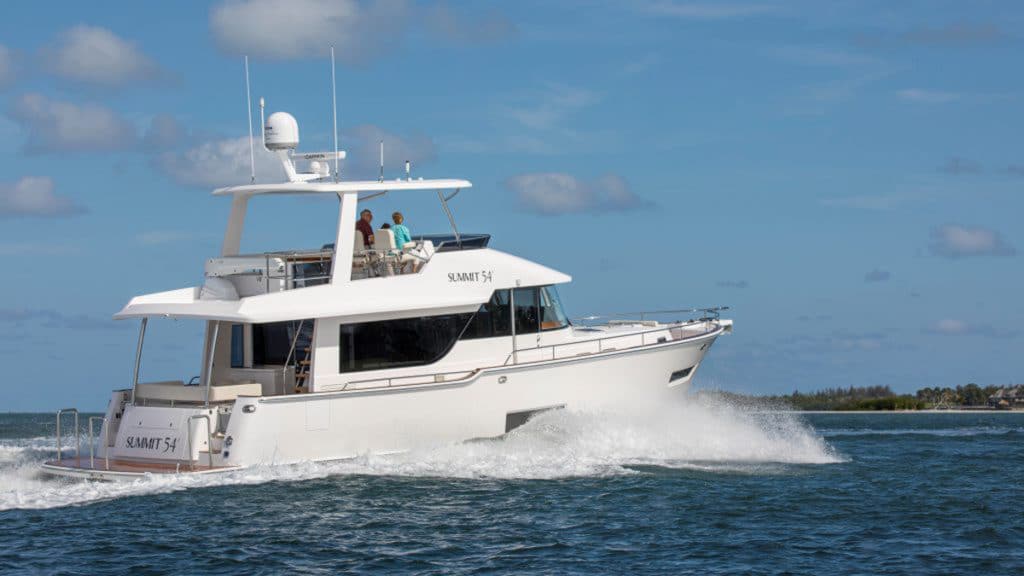
With the new and expanding Summit Motoryachts line, Kadey-Krogen lends a four-decade history of design innovation and experience building semicustom, full-displacement liveaboard yachts into the performance-cruiser market—a decision that is already proving to be successful in underscoring the caliber of the Kadey-Krogen brand.
Learn more about Summit Motoryachts at summitmotoryachts.com
The post Reaching the Summit appeared first on Yachting.
]]>The post Yachting On Board: Krogen 48 AE appeared first on Yachting.
]]>The Krogen 48 AE from Kadey-Krogen Yachts stands out as a liveaboard yacht that retains superior running characteristics, reliability, and exceptional seaworthiness and safety. Yachting got onboard the 48 AE at the 2021 Fort Lauderdale International Boat Show. Check her out with us.
About Kadey-Krogen
“At Kadey-Krogen Yachts, we understand that a certain kind of yachtsman will find us. Look at any trawler manufacturers list and you’ll find us listed among other brands. Truth be told, that list often includes some manufacturers that build yachts that are different types from what we consider to be worthy of the trawler label.
Trawler manufacturers like Kadey-Krogen make one thing, proven trawler yachts, and we do it the best way we know how. We introduce new models, but we don’t deviate from our concept: A pure full displacement hull built to handle the conditions yachtsmen encounter offshore, with an interior designed to be comfortable and liveable. How Kadey-Krogen Yachts came to be, and who is running the show today, and why they are here and what they’re doing, these are the parts that all make up the three-strand nylon that is our story.”
To see more from Kadey-Krogen, visit kadeykrogen.com.
The post Yachting On Board: Krogen 48 AE appeared first on Yachting.
]]>The post Yachting On Board: Krogen 52 appeared first on Yachting.
]]>The Krogen 52 from Kadey-Krogen Yachts is an all-oceans-capable trawler yacht with spacious liveaboard accommodations for a couple or family, making it one of the best trawlers on the market. Yachting got to check her out at the 2021 Fort Lauderdale International Boat Show. Come aboard with us!
About Kadey-Krogen
“At Kadey-Krogen Yachts, we understand that a certain kind of yachtsman will find us. Look at any trawler manufacturers list and you’ll find us listed among other brands. Truth be told, that list often includes some manufacturers that build yachts that are different types from what we consider to be worthy of the trawler label.
Trawler manufacturers like Kadey-Krogen make one thing, proven trawler yachts, and we do it the best way we know how. We introduce new models, but we don’t deviate from our concept: A pure full displacement hull built to handle the conditions yachtsmen encounter offshore, with an interior designed to be comfortable and liveable. How Kadey-Krogen Yachts came to be, and who is running the show today, and why they are here and what they’re doing, these are the parts that all make up the three-strand nylon that is our story.”
To see more from Kadey-Krogen, visit https://www.kadeykrogen.com/.
The post Yachting On Board: Krogen 52 appeared first on Yachting.
]]>The post Kadey-Krogen Unveils the Krogen 60 Open appeared first on Yachting.
]]>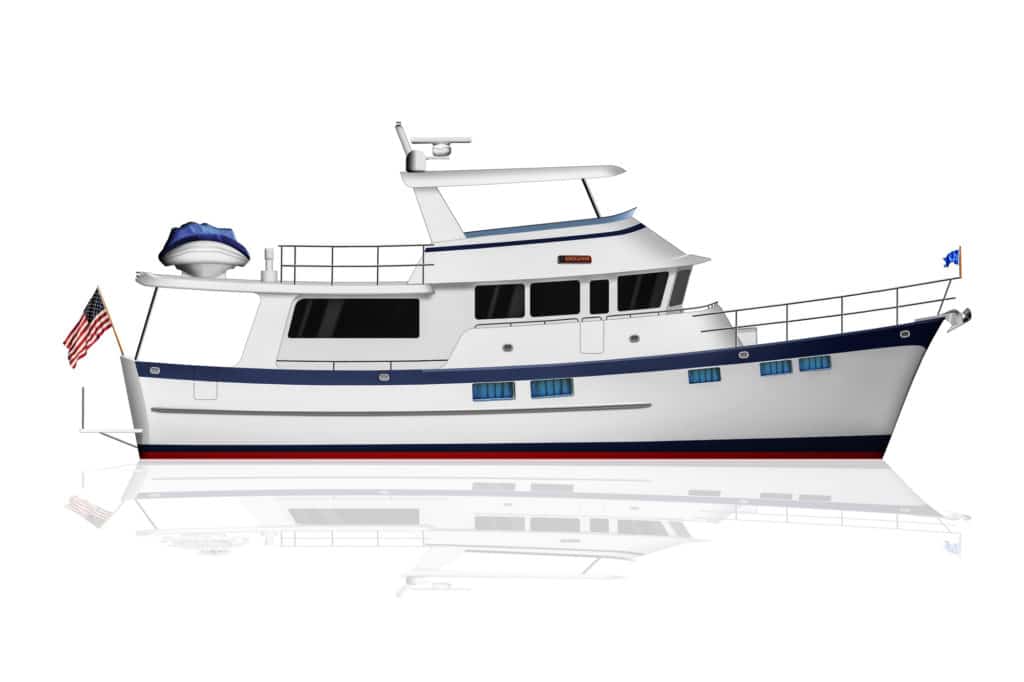
Kadey-Krogen Yachts has unveiled the design of the Krogen 60 Open.
The Krogen 60 Open will fall between the Krogen 58 and the Krogen 70 in the builder’s model lineup. The 60 will have the same open-living concept that the builder first used on the Krogen 50 Open, joining the salon and galley with the pilothouse.
Owners of the Krogen 60 Open will be able to add a day head in the pilothouse, and crew’s quarters abaft the engine room. Belowdecks is an amidships master stateroom with a king-size berth. There are several interior layout options, including a three-stateroom, three-head layout with a convertible office.
Power will be a pair of 200-horsepower John Deere 4045 diesels, which Kadey-Krogen says will provide transoceanic range. Beam on the Krogen 60 Open will be 19 feet, 6 inches, and draft will be less than 6 feet, making the yacht suitable for cruising shallow waters such as the Bahamas.
When will the first Krogen 60 Open launch? Look for the new model to splash in 2023.
Take the next step: Go to kadeykrogen.com
The post Kadey-Krogen Unveils the Krogen 60 Open appeared first on Yachting.
]]>The post Looking for a Pre-Owned Kadey-Krogen? appeared first on Yachting.
]]>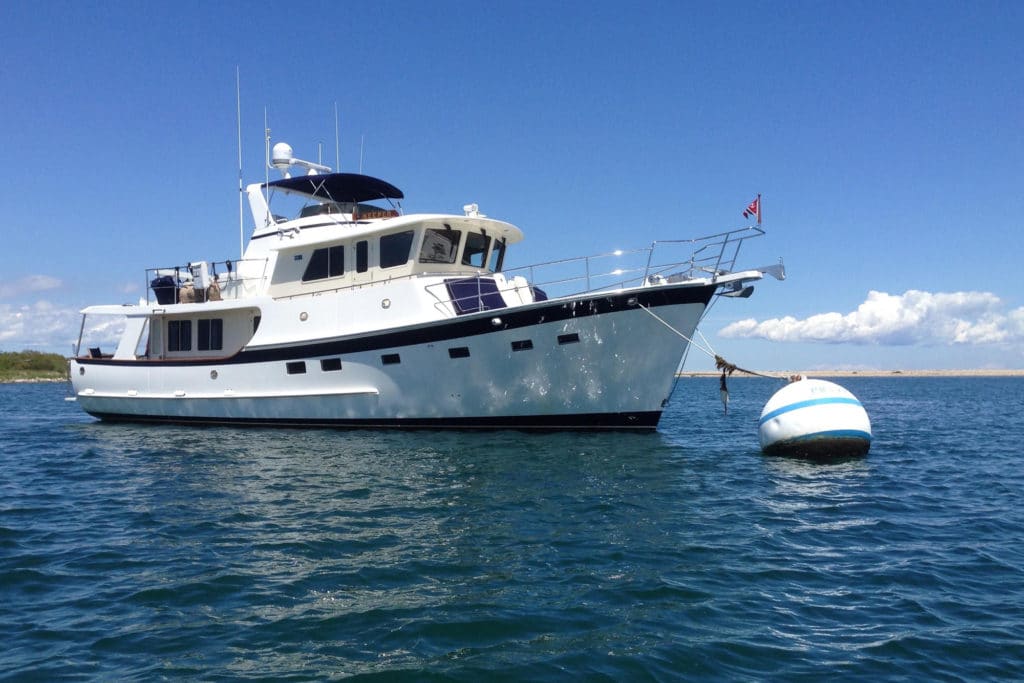
Kadey-Krogen Yachts is exclusively promoting the sale of two Kadey-Krogen hulls that launched in 2013.
The first is Keeper, a Kadey-Krogen 52 with an asking price of $1,450,000 in Southport, North Carolina.
Keeper was built with the twin-engine option and has a draft of 4 feet, 6 inches, allowing her to cruise comfortably offshore or in the shallower waters of destinations such as the Bahamas. Additional features include bow and stern thrusters, as well as stabilizers.
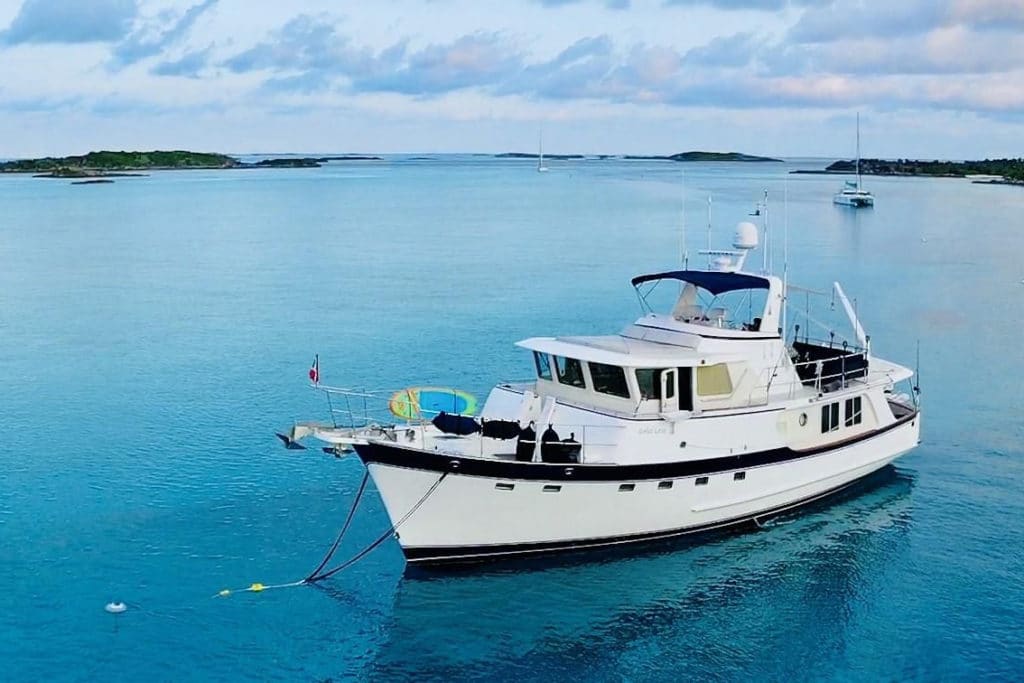
The second yacht for sale is Stella Luna, a Kadey-Krogen 58 with an asking price of $1,525,000 in Stuart, Florida.
Stella Luna has a three-stateroom layout that includes a custom, king-size master berth, an 8-foot sun pad atop the pilothouse, an L-shaped outdoor lounge with a sunshade, and multicolor underwater lights. Stella Luna has had two owners, and Kadey-Krogen describes the yacht as “turnkey.”
What else is happening at Kadey-Krogen? The builder expects to be at the Newport International Boat Show in September, with a Krogen 50 Open and a Summit 54 on display.
Take the next step: For information about Keeper, contact sales broker Bill Harris, and for Stella Luna, contact sales broker John Gear, both at kadeykrogen.com
The post Looking for a Pre-Owned Kadey-Krogen? appeared first on Yachting.
]]>The post Reviewed: Summit Motoryachts 54 appeared first on Yachting.
]]>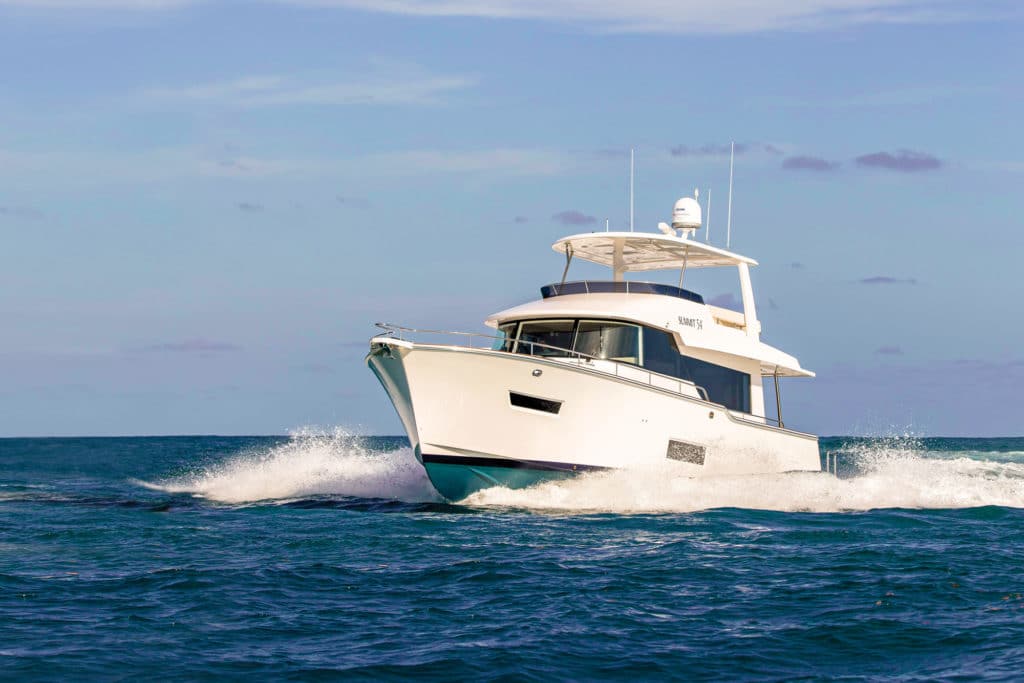
How does one define outstanding luxury on a motoryacht?
After all, you’d be hard-pressed to find a modern motoryacht that didn’t have a gorgeous interior, comfortable seating, climate-control zones and plush fabrics. Naturally, you’ll find all these things aboard the Summit Motoryachts 54.
But the true nature of luxury aboard this yacht stays hidden until—and even after—you start the engines. I know this because my ears suddenly awakened to the fact that 1,084 rumbling diesel horses in the engine room were barely audible at the helm station. Or, for that matter, anywhere on the boat.
I found this absence of racket both pleasing and curious, so I slid open the aft salon door and discovered that the engine room was so well-insulated via the 32 mm Pyrotek Sorberflex soundproofing and aluminum shielding that it made little difference in cabin sound levels whether the door was open or closed. That means owners can enjoy the fresh sea breeze along with peace and quiet either on the hook or underway.

As much as I loved the serene nature of the quiet cabin, opening and closing that double sliding door also left me staring at the frame that surrounds it and the opening window between the cockpit and salon. The frame is a single 500-pound piece of glimmering polished stainless steel. In fact, there’s more stainless steel in this one frame than aboard some other motoryachts in total. It’s so strong, it eliminates the need for a separate structural support for the flybridge. Overall, the door-and-window frame is as much a work of metallic art as it is a functional structure.
The rest of the Summit 54 is built with a similarly stout nature, as anyone who has ever been aboard a Kadey-Krogen trawler would expect. The motoryacht’s hull is solid fiberglass from the waterline down, while major components above the waterline are cored and reinforced with E-glass. Skin coats are the more-expensive vinylester resin to act as a barrier against water intrusion and blistering. Countertops are Silestone, faucets and fixtures are Grohe and Kohler, and the carpet is Stainmaster Luxerell.

Virtually every component belowdecks is also top-shelf—although I found it tougher to stay focused on construction when I walked down the companionway, where I was met with a rather unusual arrangement. For starters, the companionway itself isn’t on centerline; it’s to port. This made for plenty of elbow room when I looked to starboard, where there was a guest stateroom, or when I turned aft to enter the full-beam master stateroom.
That master is unusual too. Rather than having the queen berth extend from the after bulkhead, the designers placed it athwartships to starboard. The head is located along the port side of the yacht. The layout allows for easy access to both sides of the berth along most of its length and provides headroom running the length of the stateroom. The space includes a stall shower larger than some you’ll find in Manhattan apartments, a vanity and sink, and a separate compartment for the head itself.
Forward, the VIP stateroom is arranged in a more-traditional fashion with a centerline queen berth, a pair of hanging lockers aft and private access to the day-head. On this particular Summit 54, the smaller guest stateroom was set up with a single berth, a workstation and a washer/dryer. This room, however, can be fitted with over/under berths or turned into an office.

More about that washer/dryer: It’s a great indication that the Summit 54 was built by people who know the ins and outs of spending extended time aboard a boat. These are full-size units, not mini appliances that can handle all of two T-shirts and a pair of shorts.
Similarly, the galley has not one but two sets of undercounter refrigerator and freezer drawers, and the convection/microwave oven is a full-size Samsung. This is a motoryacht built for cruising.
It’s easy to step aboard any modern motoryacht and find examples of luxury. It is not easy, however, to find examples of luxury that are missing on countless other motoryachts. But don’t listen to me; stand at the helm, start the engines and listen to the sound of near silence. You just might hear the Summit Motoryachts 54 calling you.
Take the next step: summitmotoryachts.com
The post Reviewed: Summit Motoryachts 54 appeared first on Yachting.
]]>The post Inside the Kadey-Krogen 50 Open appeared first on Yachting.
]]>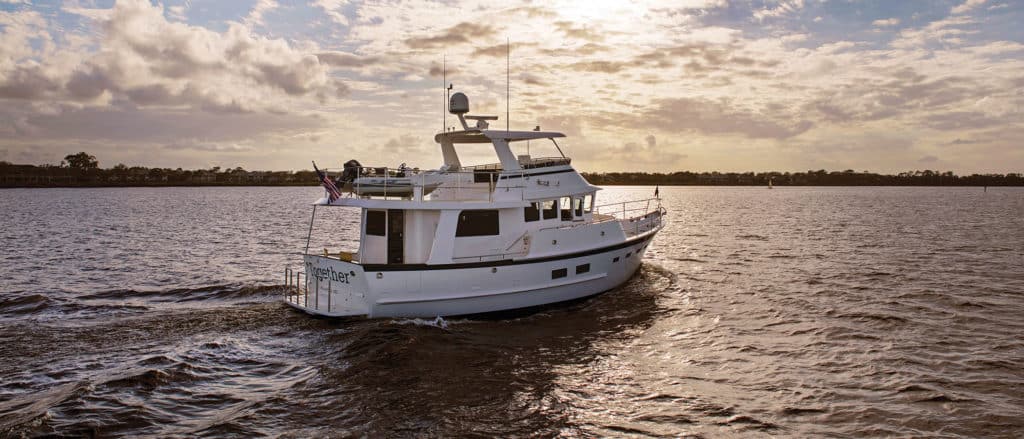
With all due respect to the world’s great boat shows large and small, the Palm Beach International Boat Show is currently my favorite. It’s manageably sized, is stress-free to get around and has easy access to good restaurants. But attending is always a bittersweet affair for me because Palm Beach heralds the end of boat-show season. However this year, as the show wound down, there was light at the end of the tunnel. It took the form of the Kadey-Krogen 50 Open. Kadey-Krogen vice president and partner Larry Polster invited me to help him deliver the 50 from West Palm Beach to Stuart, Florida, after the show. I’d first gotten aboard at the Miami International Boat Show a month earlier, and based on what I’d seen, my answer was an enthusiastic yes. The yacht’s open, uncluttered main deck puts the helm, salon and galley all on one level — as opposed to the more traditional pilothouse design seen on most trawlers. “It’s the only boat in this class I know of with an open layout like this,” Polster said with a hint of pride (that particular boat belonged to him).
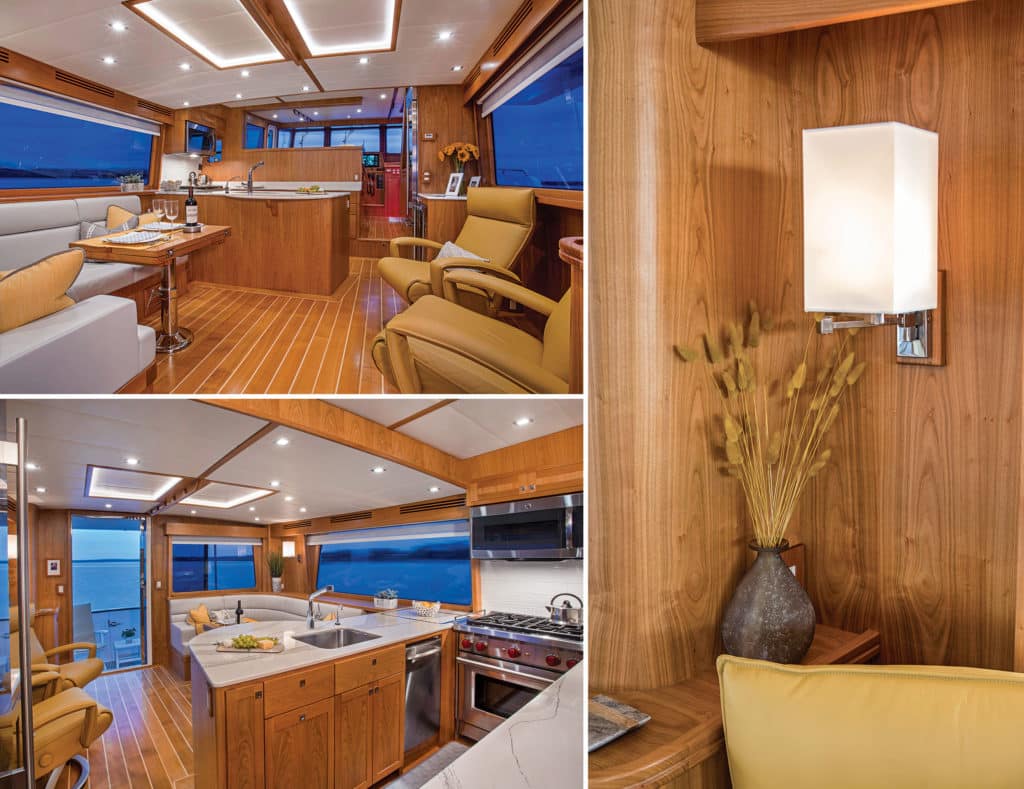
Seating is aft, adjacent to the cockpit, with an L-shaped settee to port and more seating to starboard. Forward is a galley with a Sub-Zero refrigerator and freezer, sized to hold enough food during the long voyages for which this boat is designed. There’s a four-burner Wolf range, stowage for dry goods and an optional dishwasher — a choice I’d wager will be popular. Who wants to scrub dishes aboard a beautiful boat in a scenic location?
The interior’s seating area and galley have four windows on each side for natural light. They help give the captain near-360-degree views from the helm, which is up one step with a Llebroc helm chair, a 29-inch-wide cherry wheel and the owner’s choice of electronics. Polster opted for twin 22-inch Garmin screens, as well as an ABT-Trac stabilizer joystick. He likes that stabilizing system for a yacht that, at half-load, displaces 68,000 pounds.
An L-shaped settee with a foldout table is to port for keeping the captain company, and a watertight door to starboard accesses a Portuguese bridge with wing stations on both sides for docking. Polster’s wing stations also have Garmin screens, ZF controls and access to the stabilizer system.
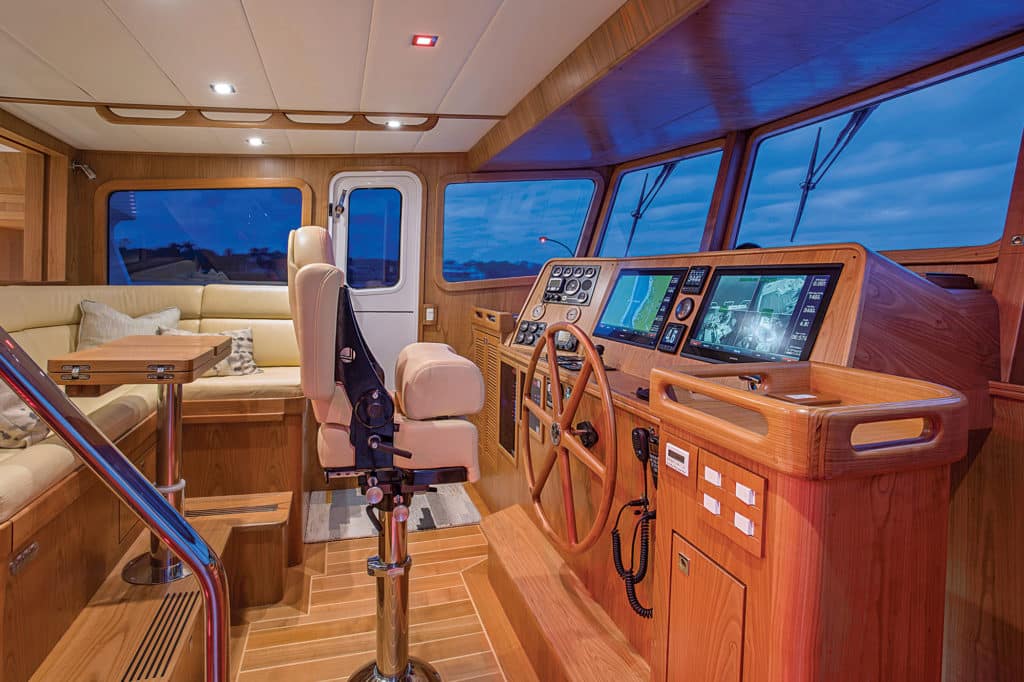
From there, the 25-inch-wide side decks lead aft to the cockpit, and the Portuguese bridge has a door that leads to the yacht’s foredeck, which is girded by beefy 2-inch-wide bow rails. The bow has a Maxwell 2500 stainless-steel windlass and a settee for two to optimize time on the hook.
Once I had a good working knowledge of the yacht, Polster and I pulled lines and made for the inlet. We poked along the Intracoastal Waterway at a steady 1,800 rpm and 8 knots. At that speed, the 50 has a range of 2,100 nautical miles — leggy enough to get us from West Palm Beach all the way up to about Halifax, Nova Scotia, on one tank of fuel, had we desired.
Once we got outside protected waters, the boat performed admirably in the rolling and confused 3s and 4s. The hull has soft chines and a curved after end, much like the characteristics of a sailboat built for cruising. The result is an efficient hull form that provided a gentle landing into the troughs of even the largest swells we came across, perhaps the odd 5-footer. A pod of dolphins lazed in our wake a good way up the coast, enjoying the free ride on a perfectly fine South Florida day.
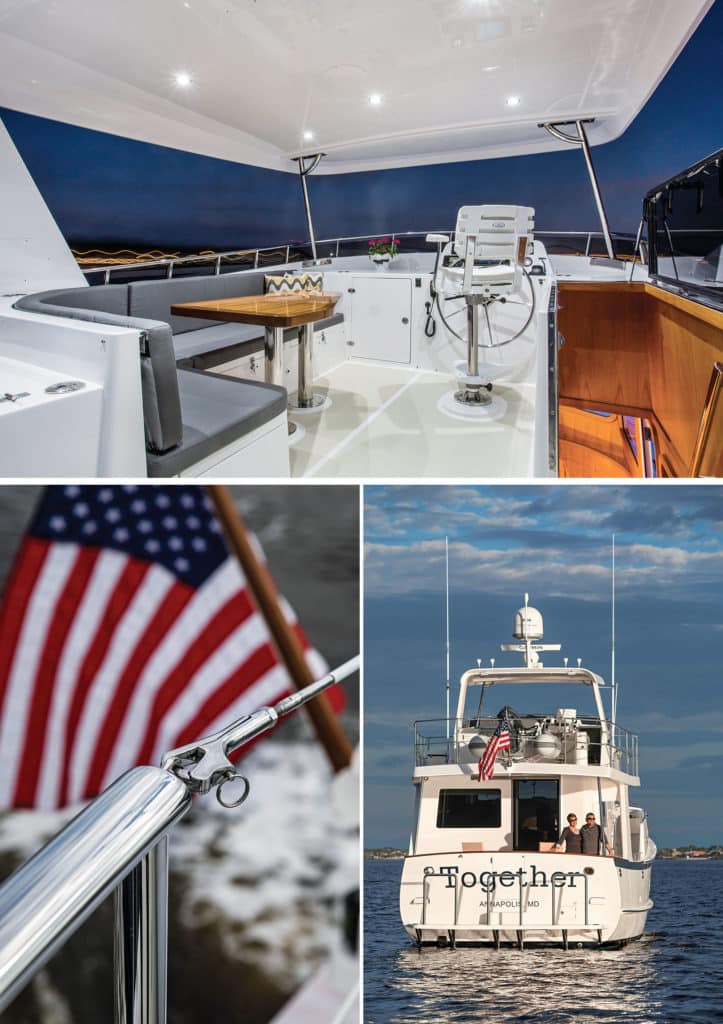
We entered the Port St. Lucie Inlet in a rousing following sea, conditions Polster likes. He wanted me to see how the boat performed on what he dubbed “the magic carpet ride,” and after experiencing it, I can see why. The 50 Open surfed cleanly and surely down the faces of the swells, with nothing but a straight white line of bubbles trailing behind.
As the marina in Stuart came into view, I couldn’t help but be a little bummed out that I was down to the last dreg of my boat-show season. But then again, with a day at sea under blues skies, aboard a vessel that’s well laid out and smooth riding, it was hard to stay down for long.
Here’s looking forward to next year.
Master and Commander
This yacht was designed for long stays aboard. Kadey-Krogen Vice President Larry Polster and his wife, Janet, left on an extended trip to the Bahamas after our sea trial. They needed comfortable accommodations, as well as a place for Polster to get some work done. The master has two hanging lockers and 12 (count ’em) cabinets and drawers for stowing clothes and other necessities. There’s also access from the master stateroom to the engine room for owners like Polster, who is hands-on when it comes to machinery maintenance. Forward of the master stateroom is an office for those days when you have to work.
Meet the Owner
Larry Polster is a partner and vice president at Kadey-Krogen Yachts, where he has worked in various capacities since volunteering to help the company at a 2002 Annapolis boat show. Polster was born and raised in Cleveland and grew up boating on the Great Lakes. By age 12 he was experienced enough to run the family’s 36-foot Pacemaker from Kingston, Ontario, to Rochester, New York, when his parents fell ill with mal de mer. After earning a degree at Carnegie Mellon University, Polster worked in consulting for 17 years before opening Kadey-Krogen’s Annapolis office shortly after that Annapolis show.
The post Inside the Kadey-Krogen 50 Open appeared first on Yachting.
]]>